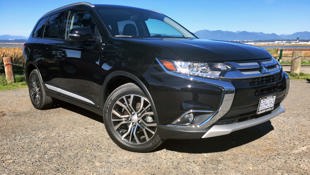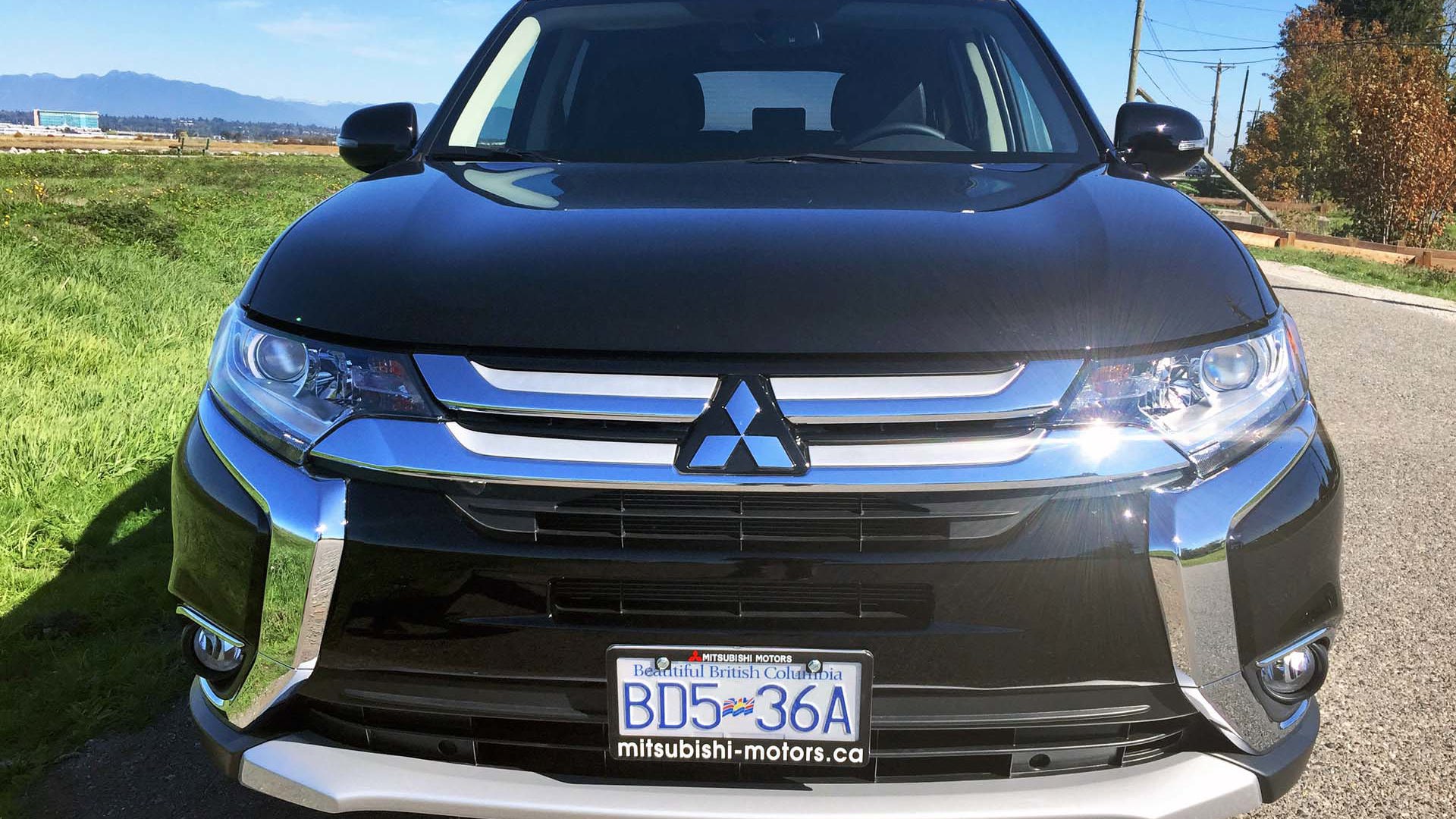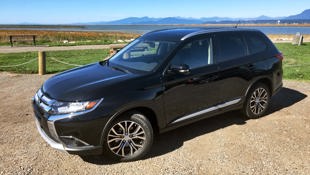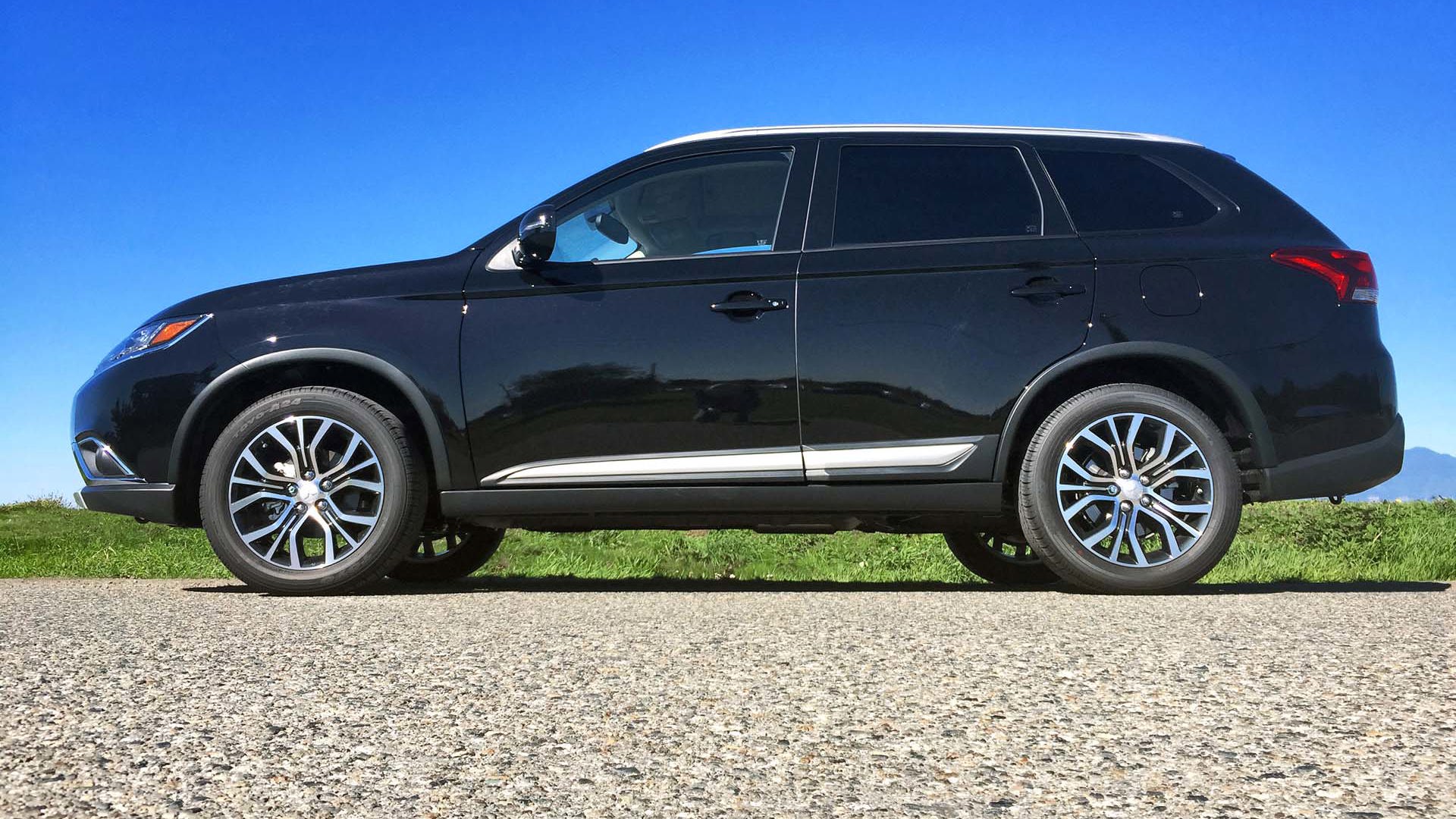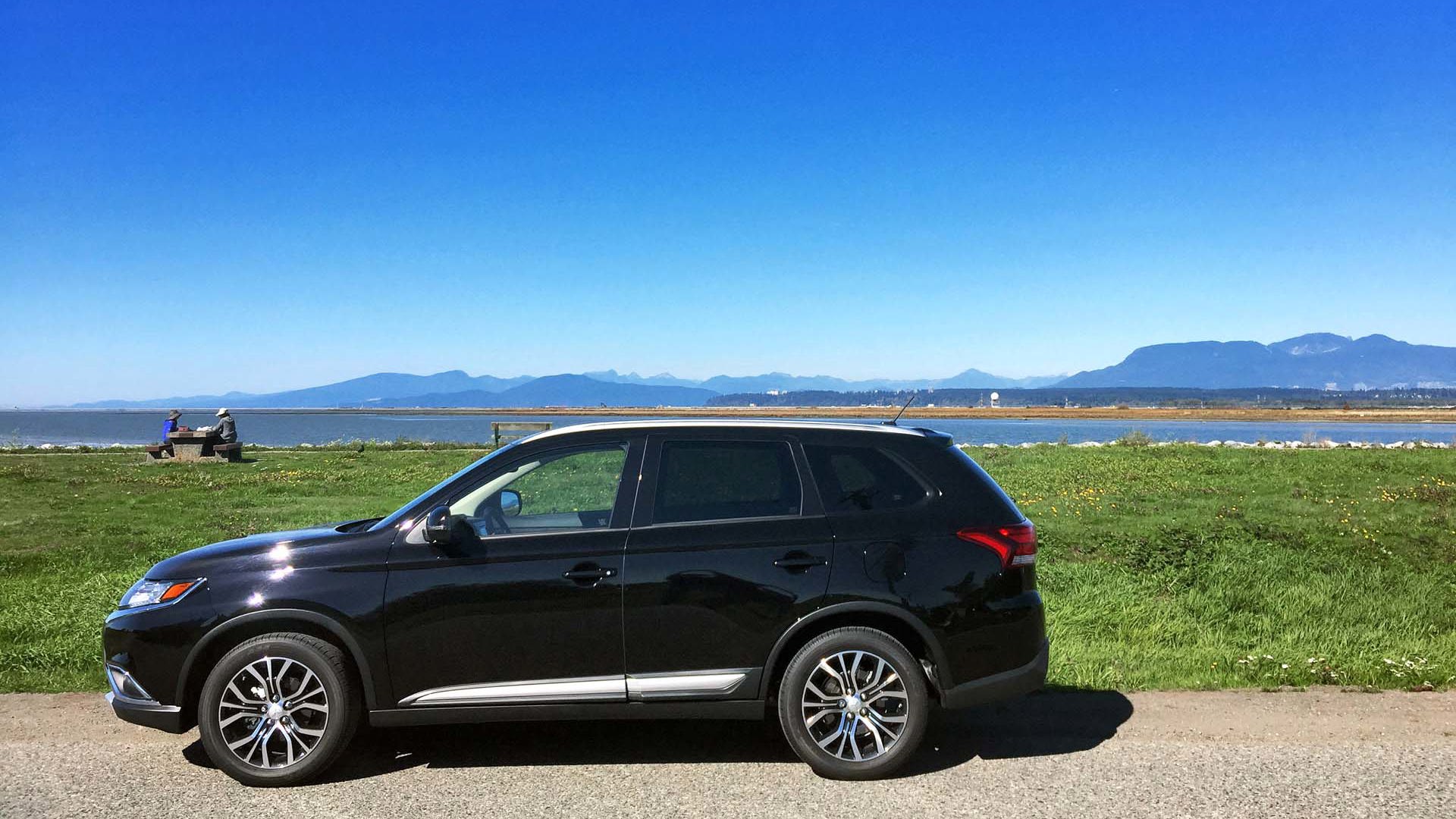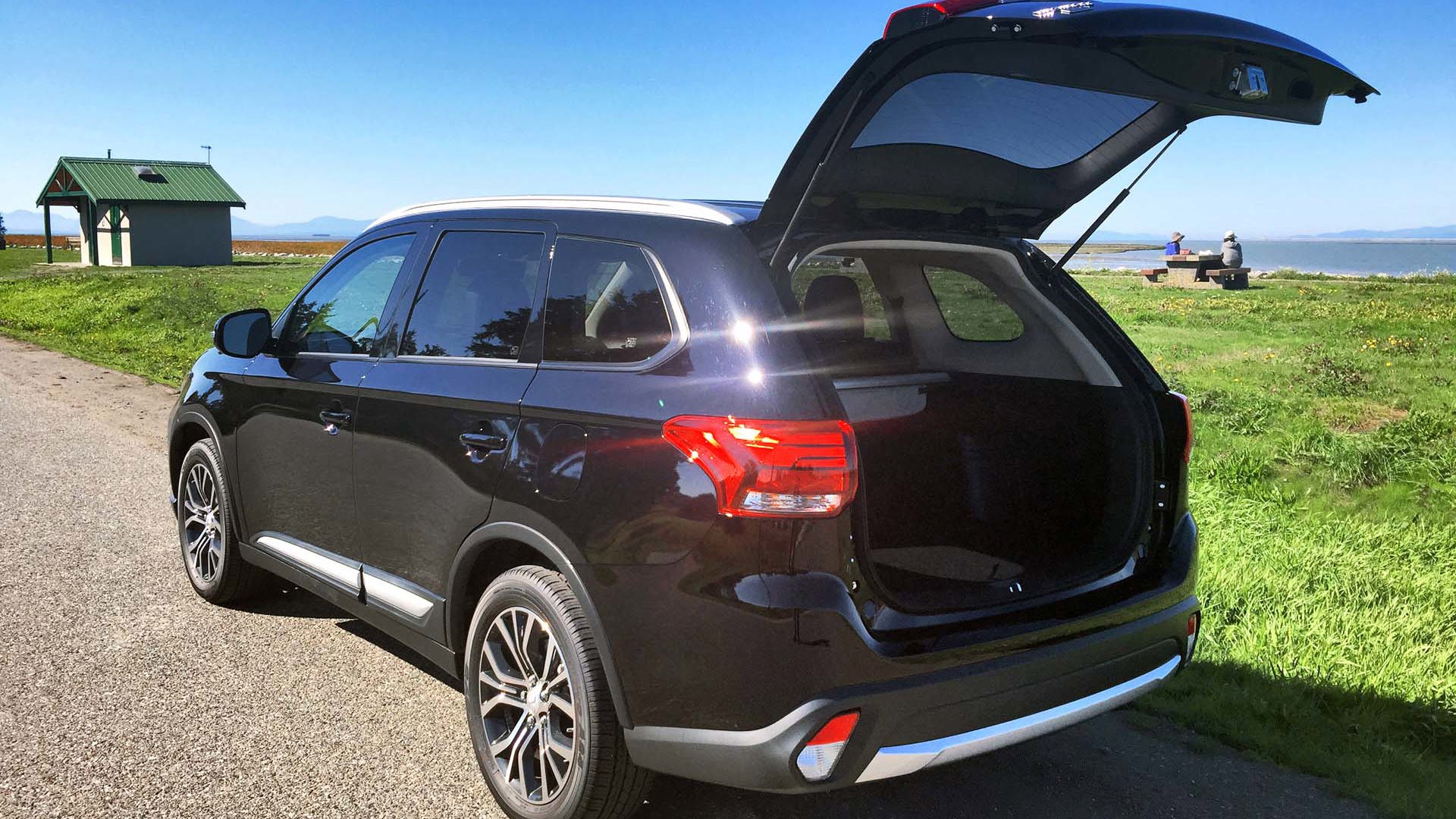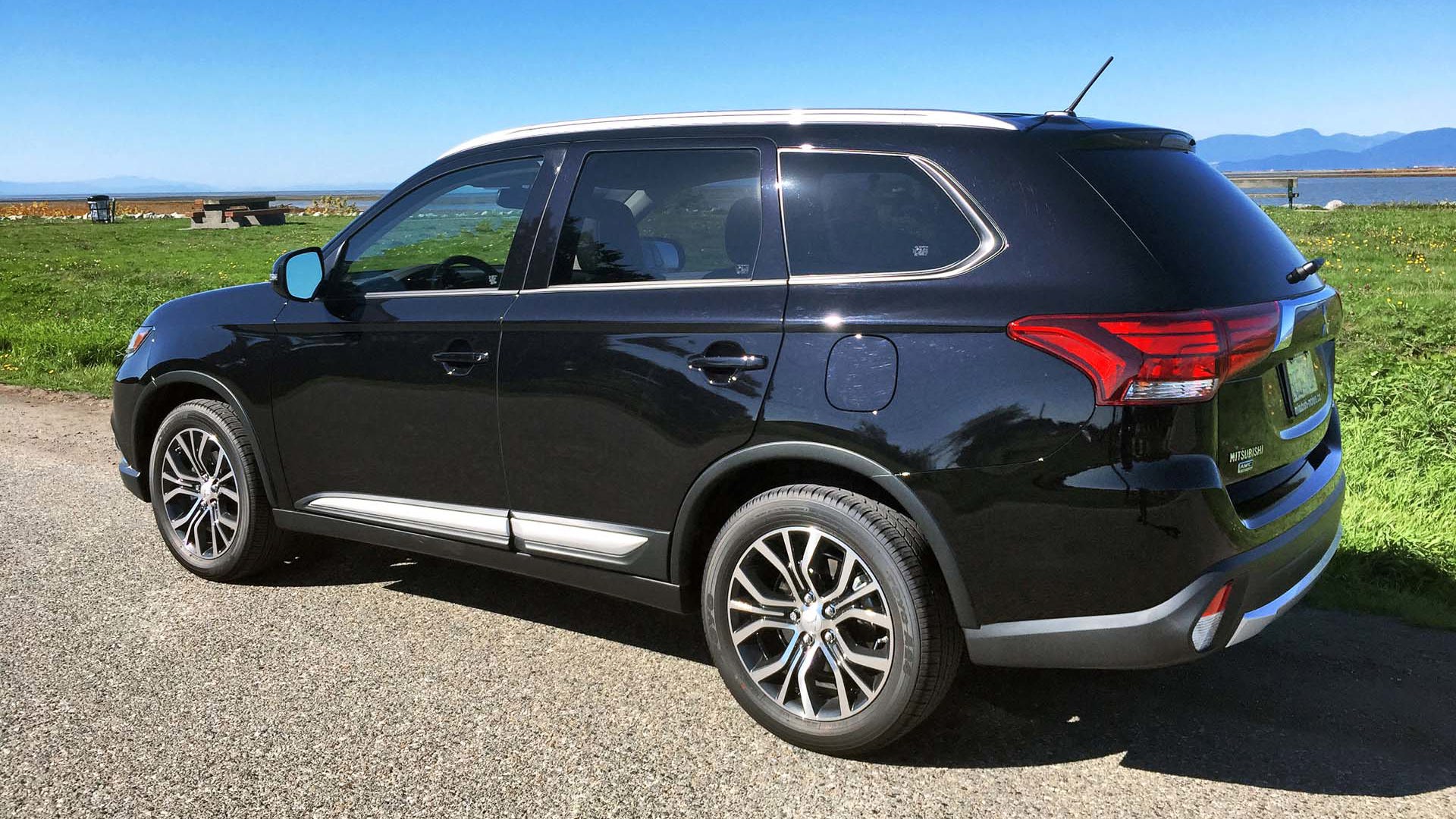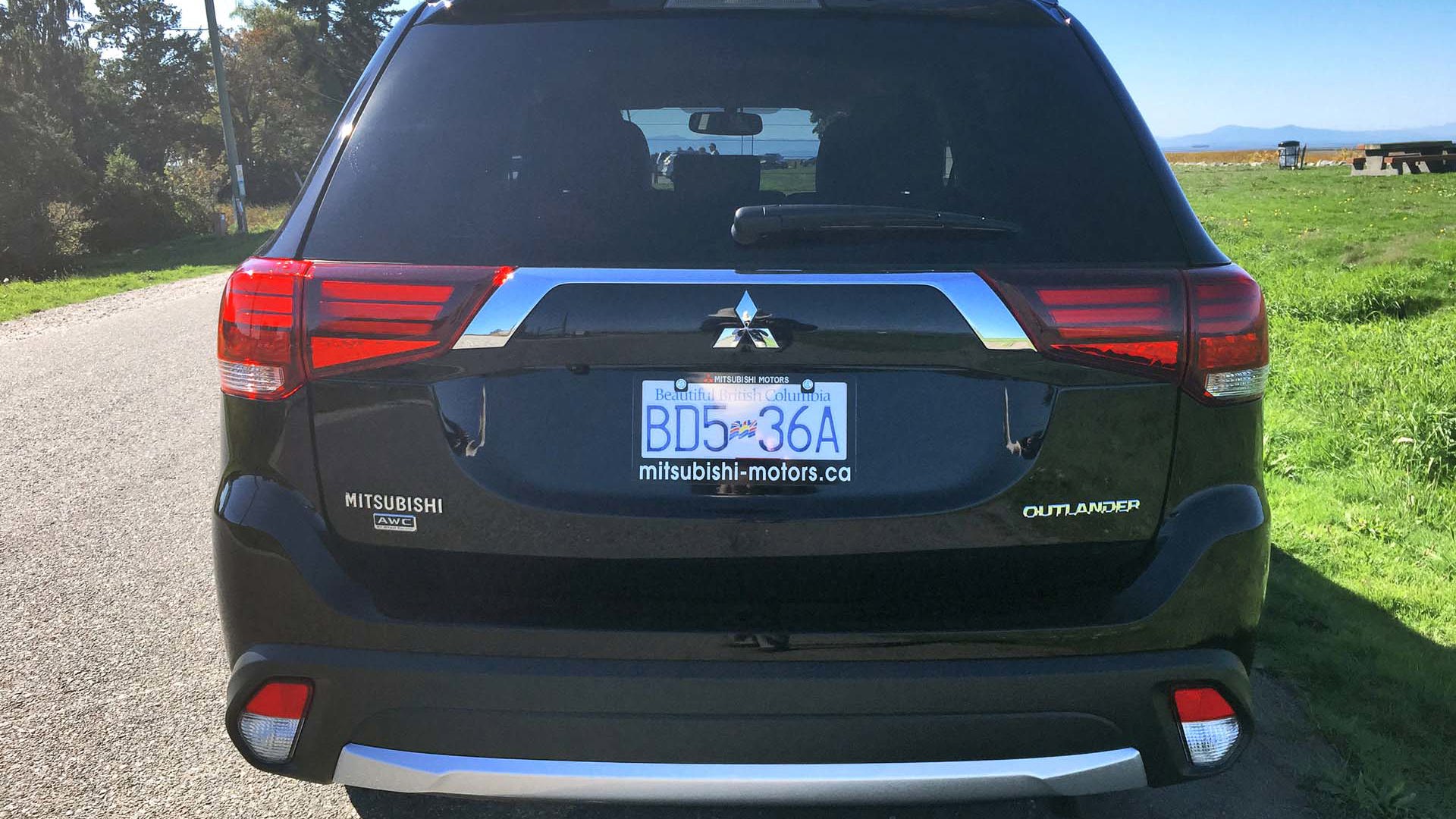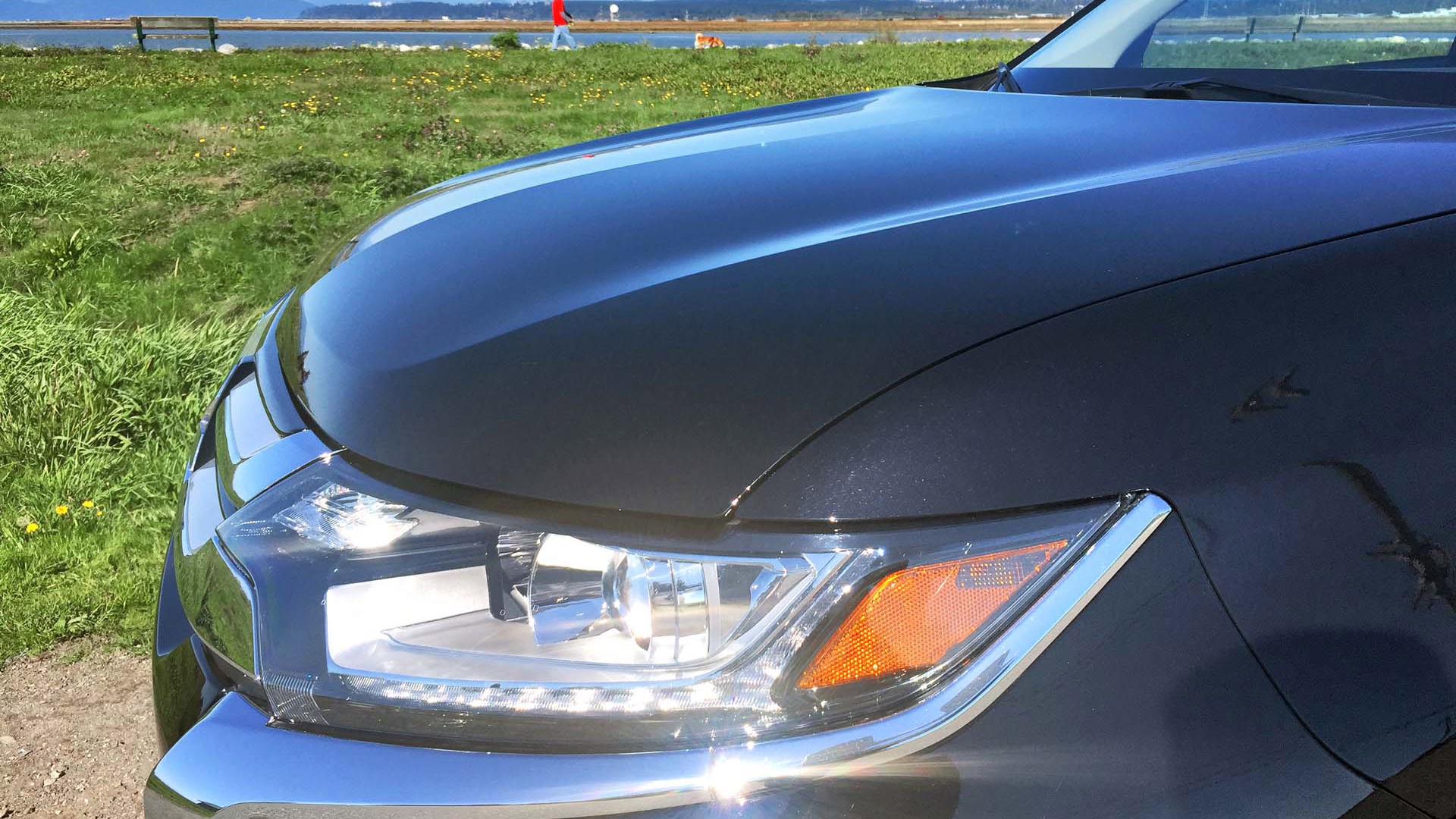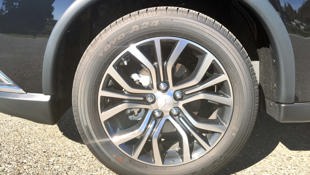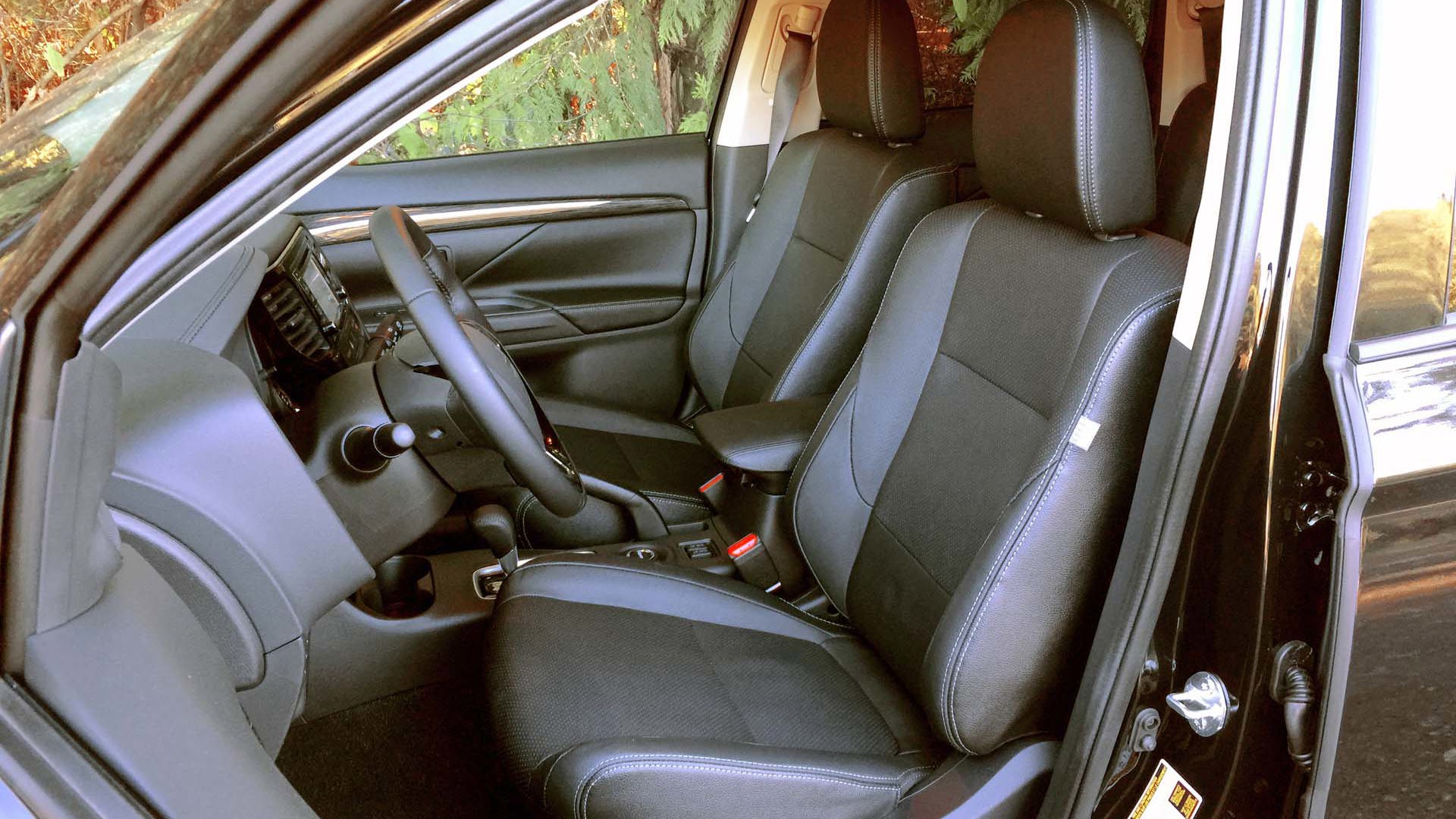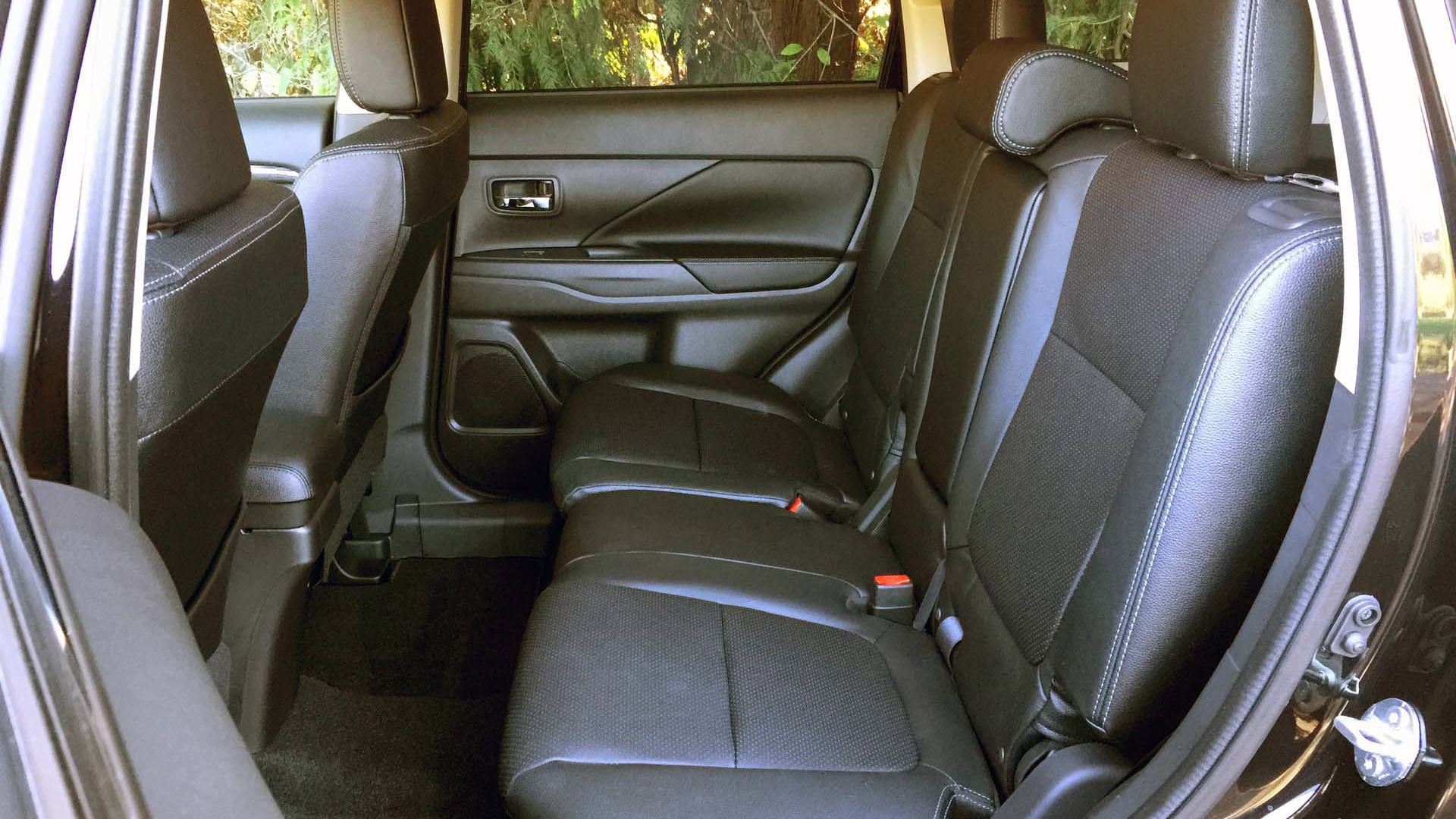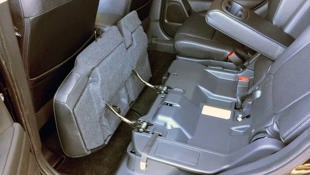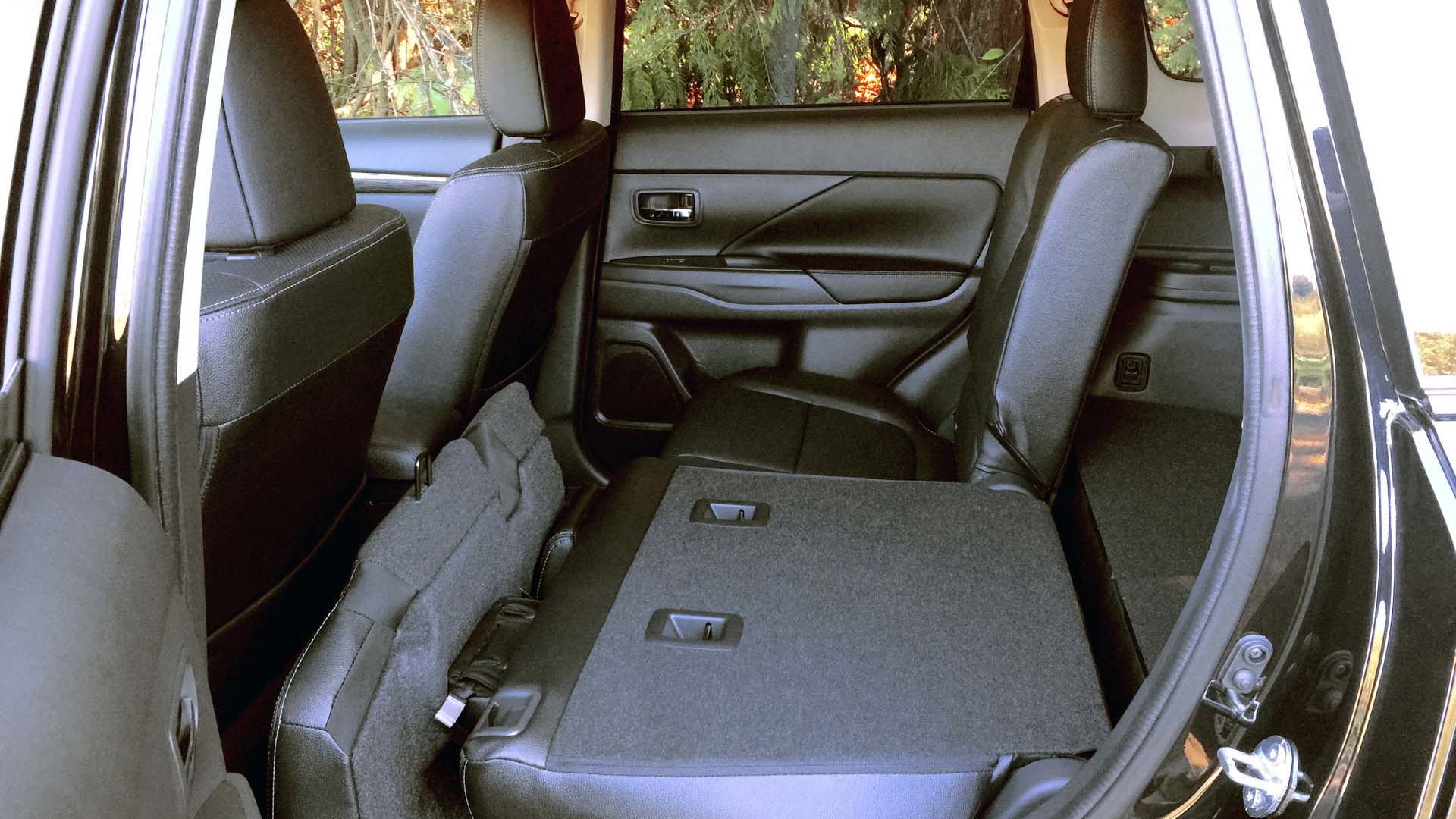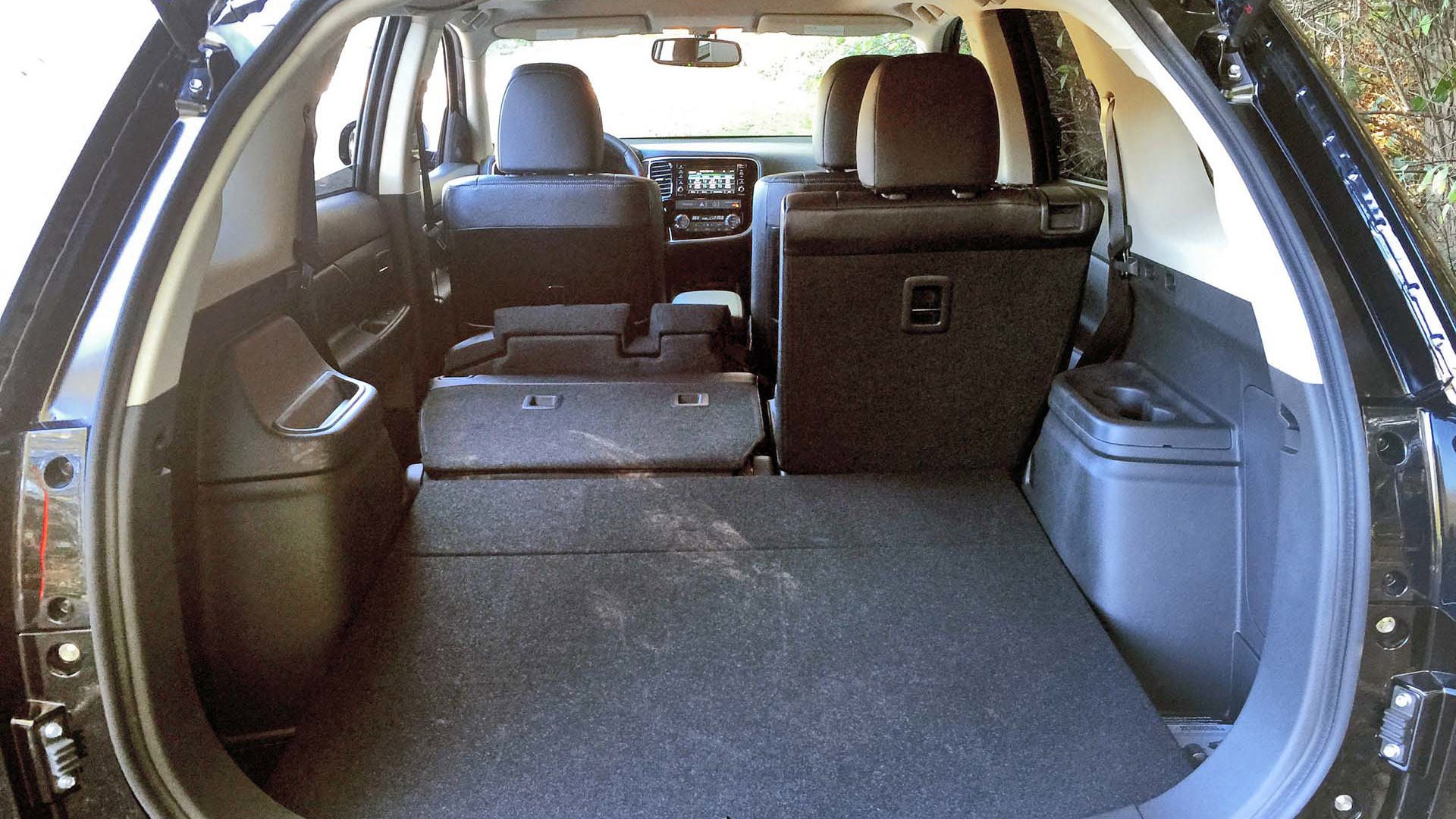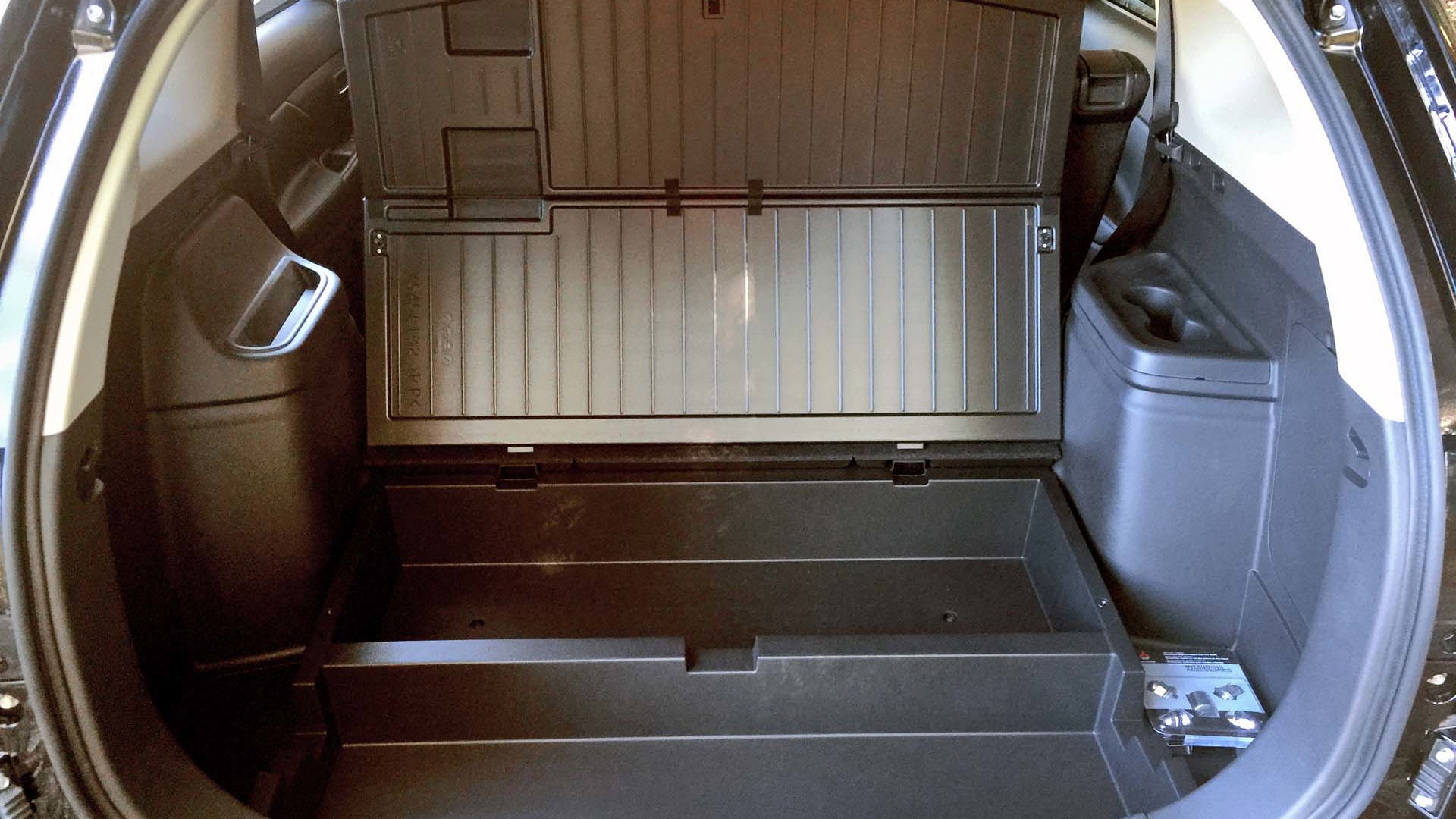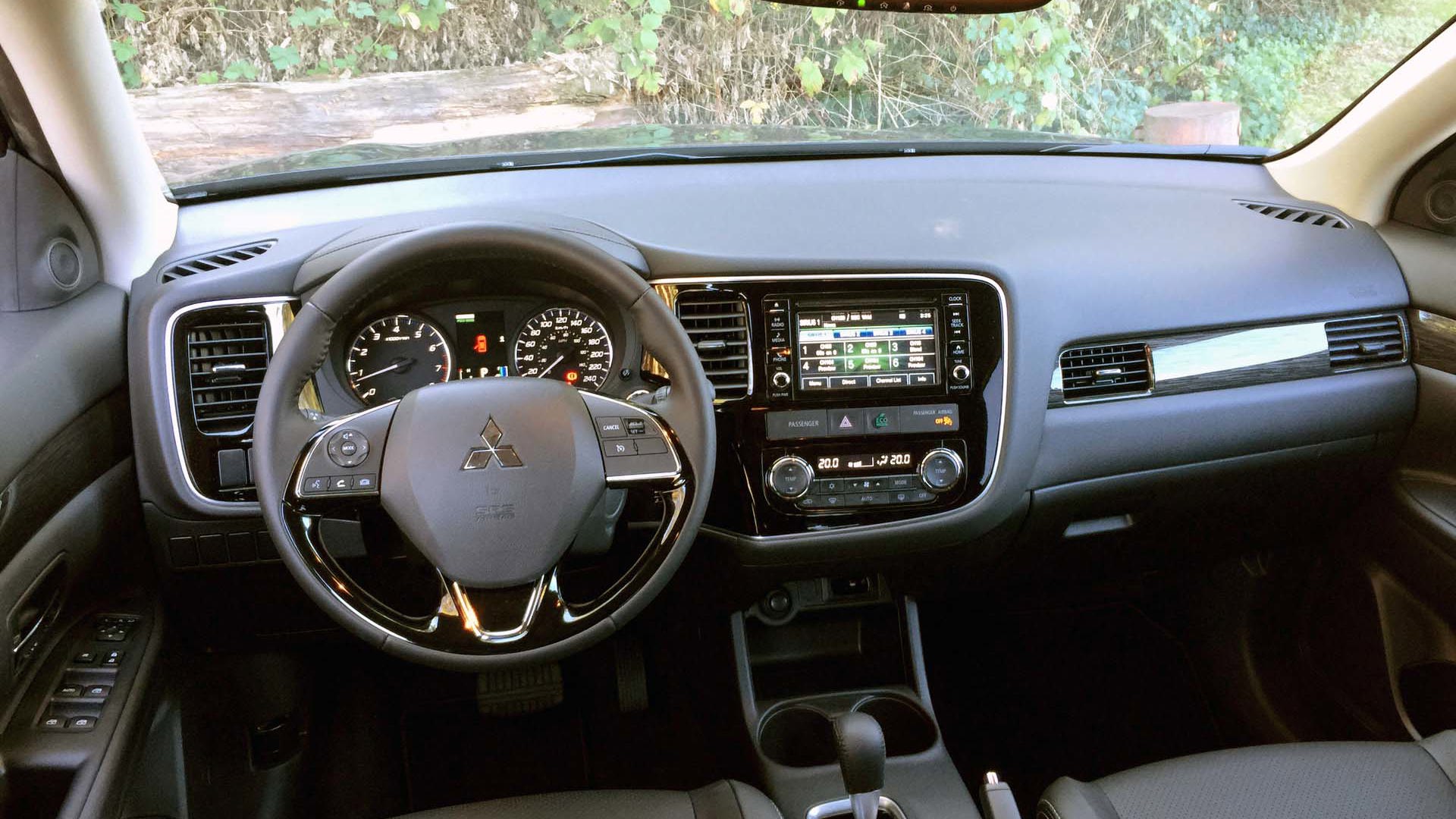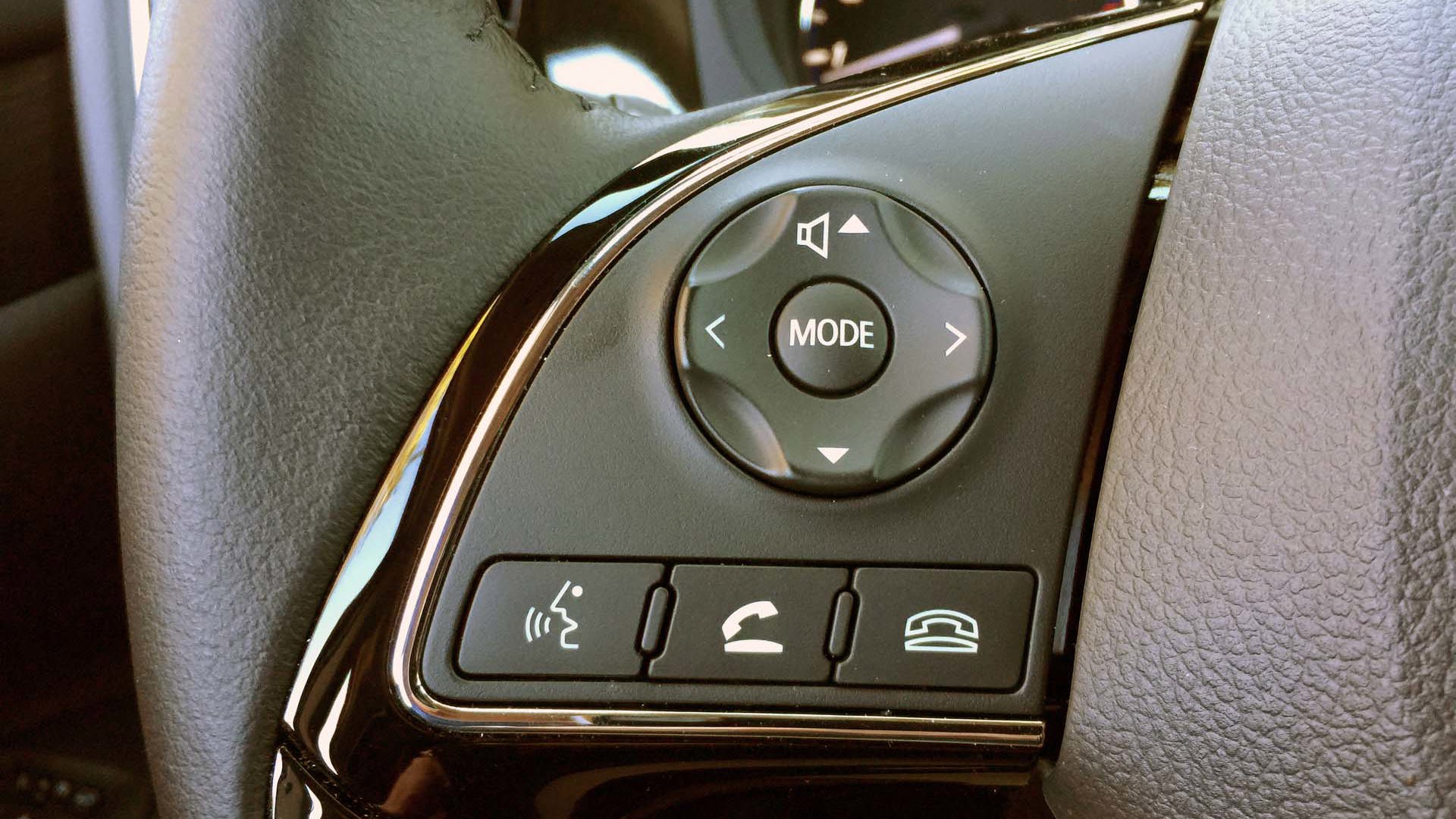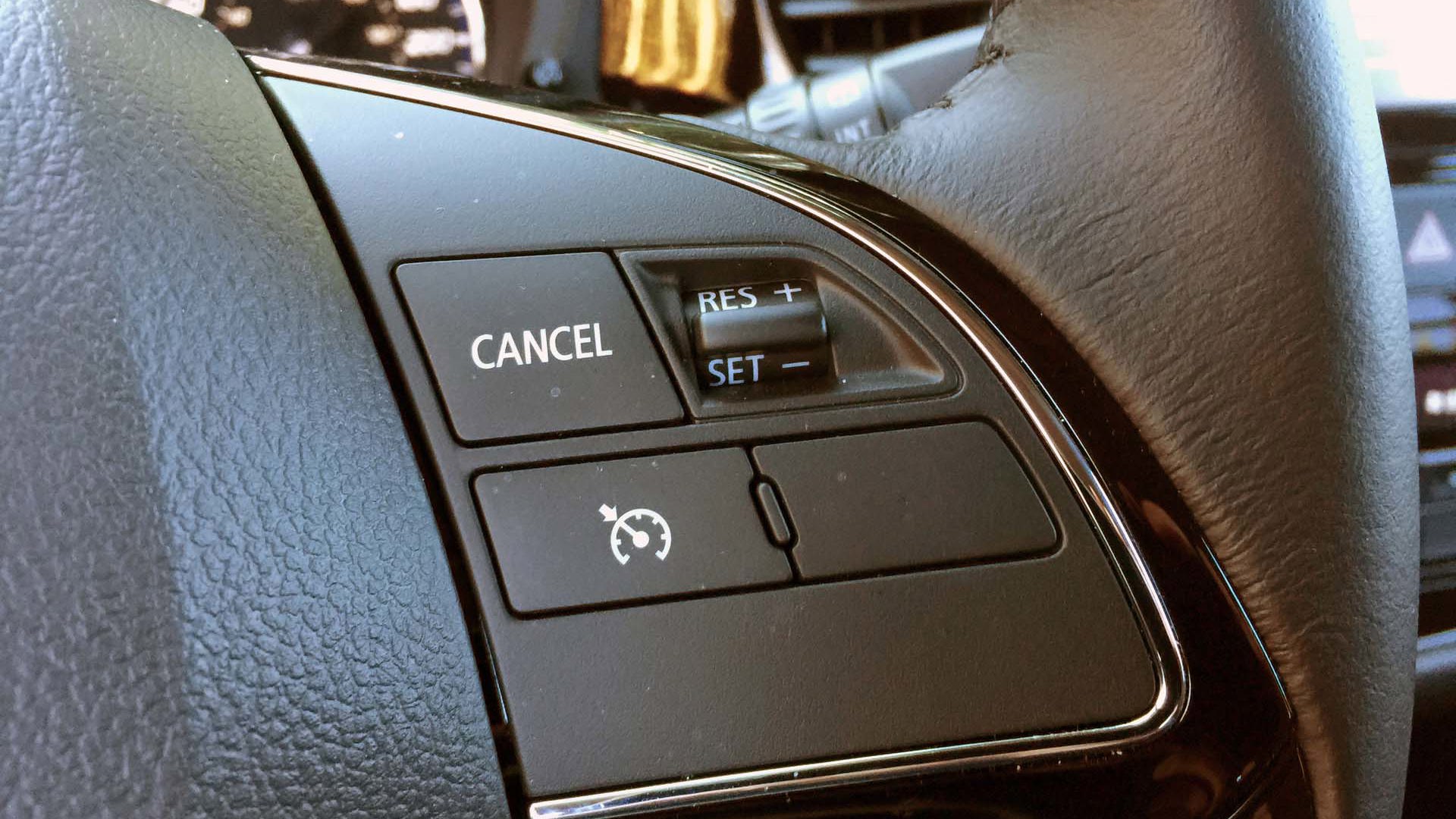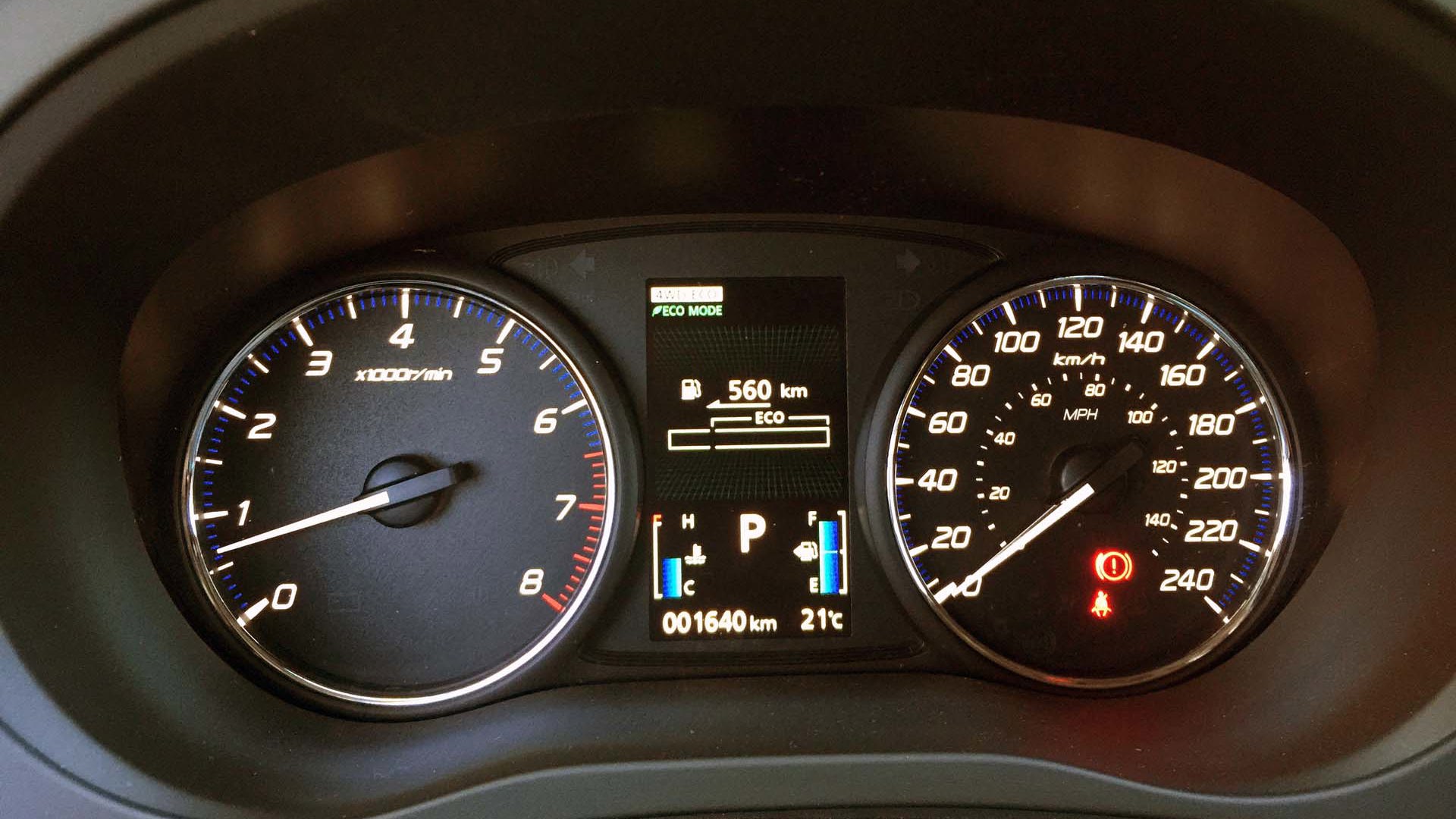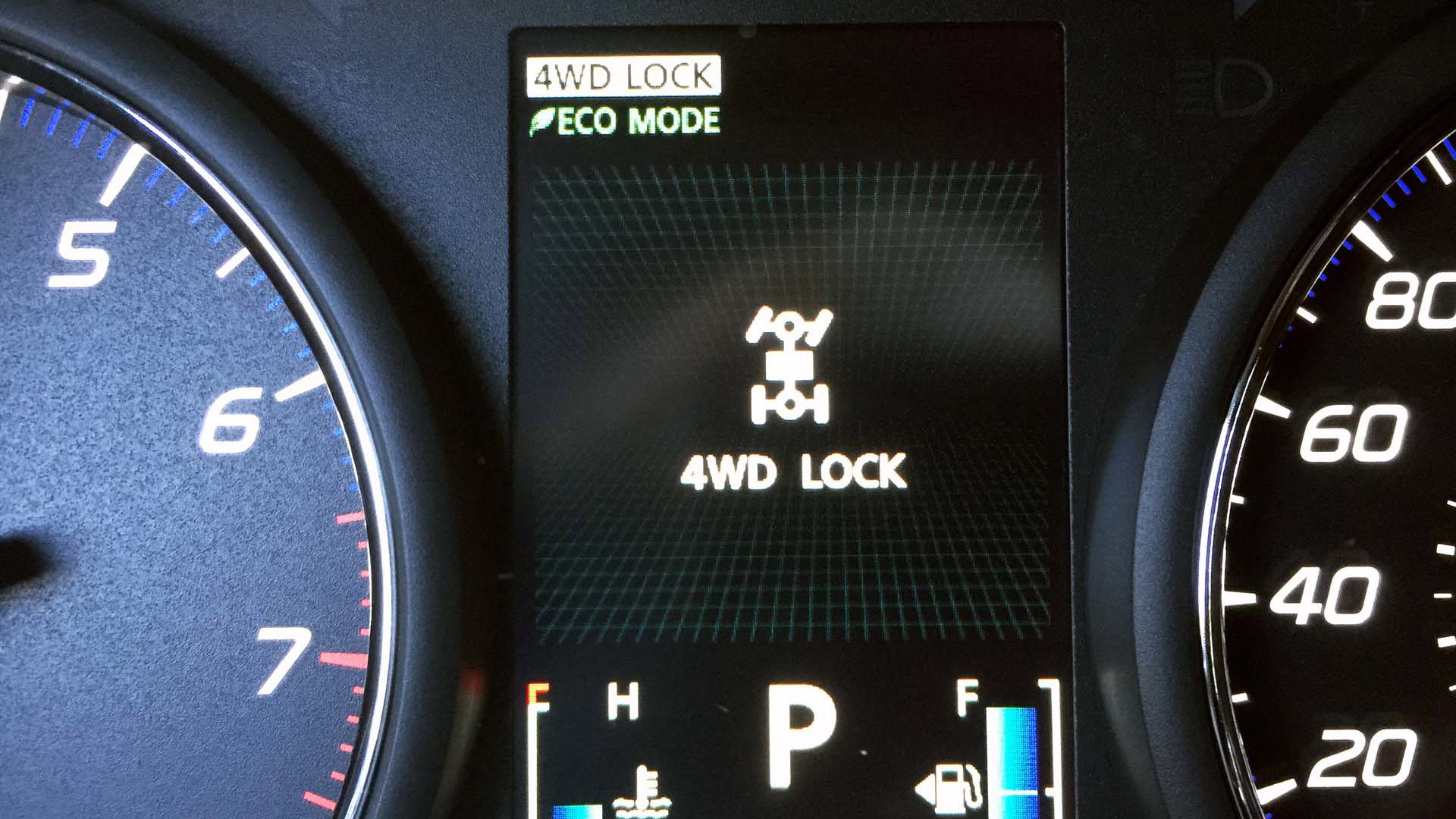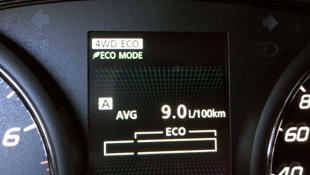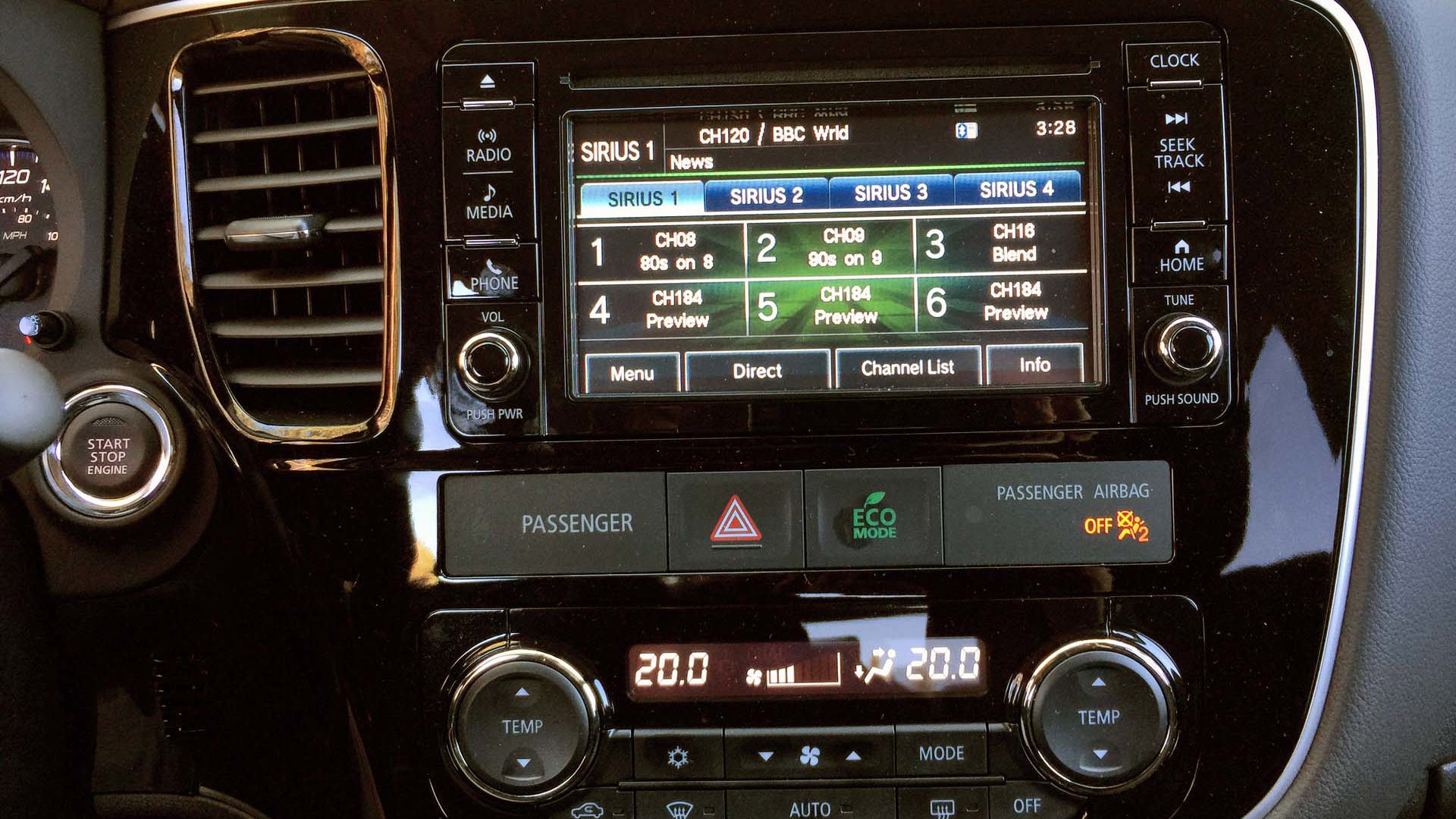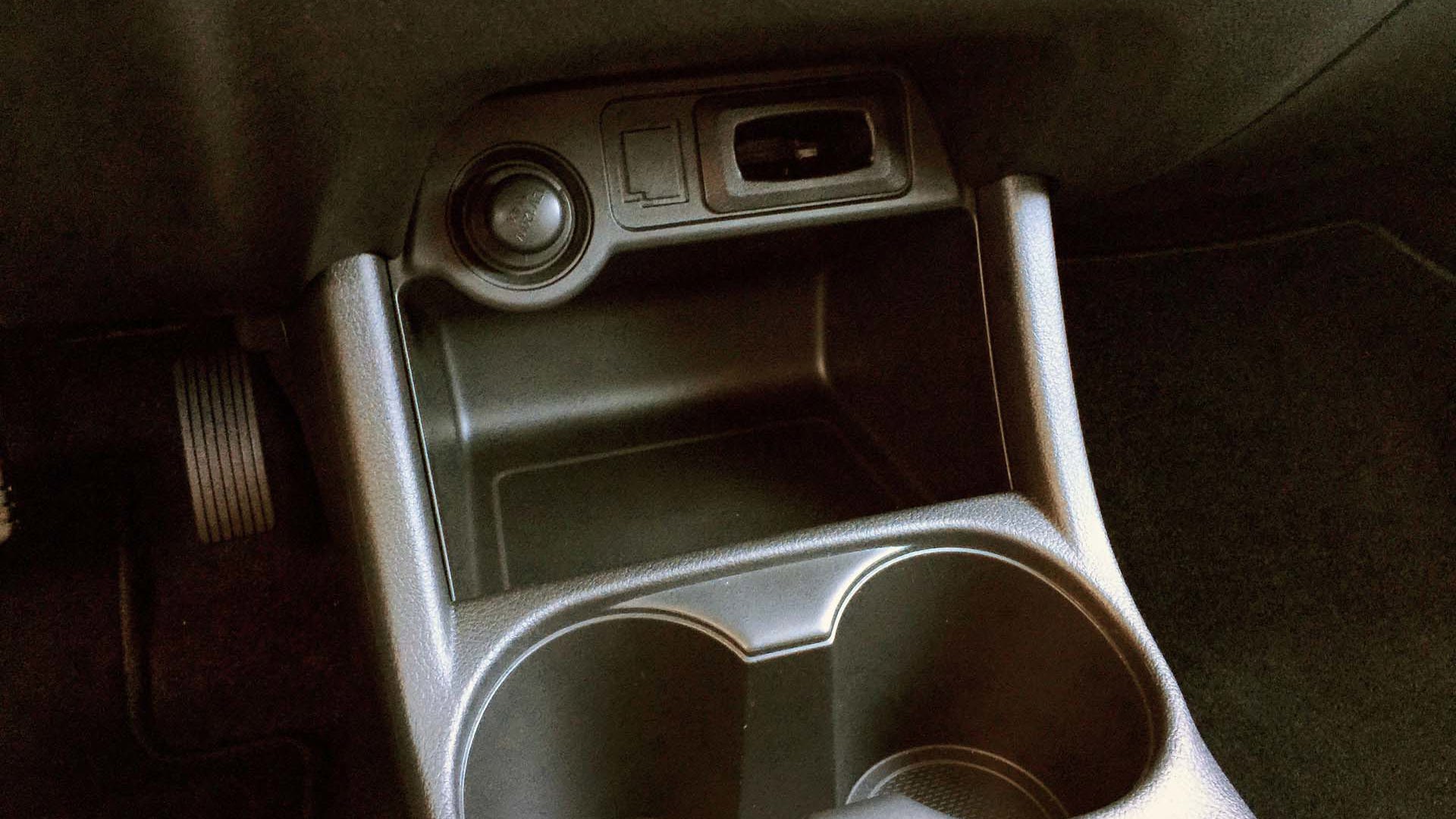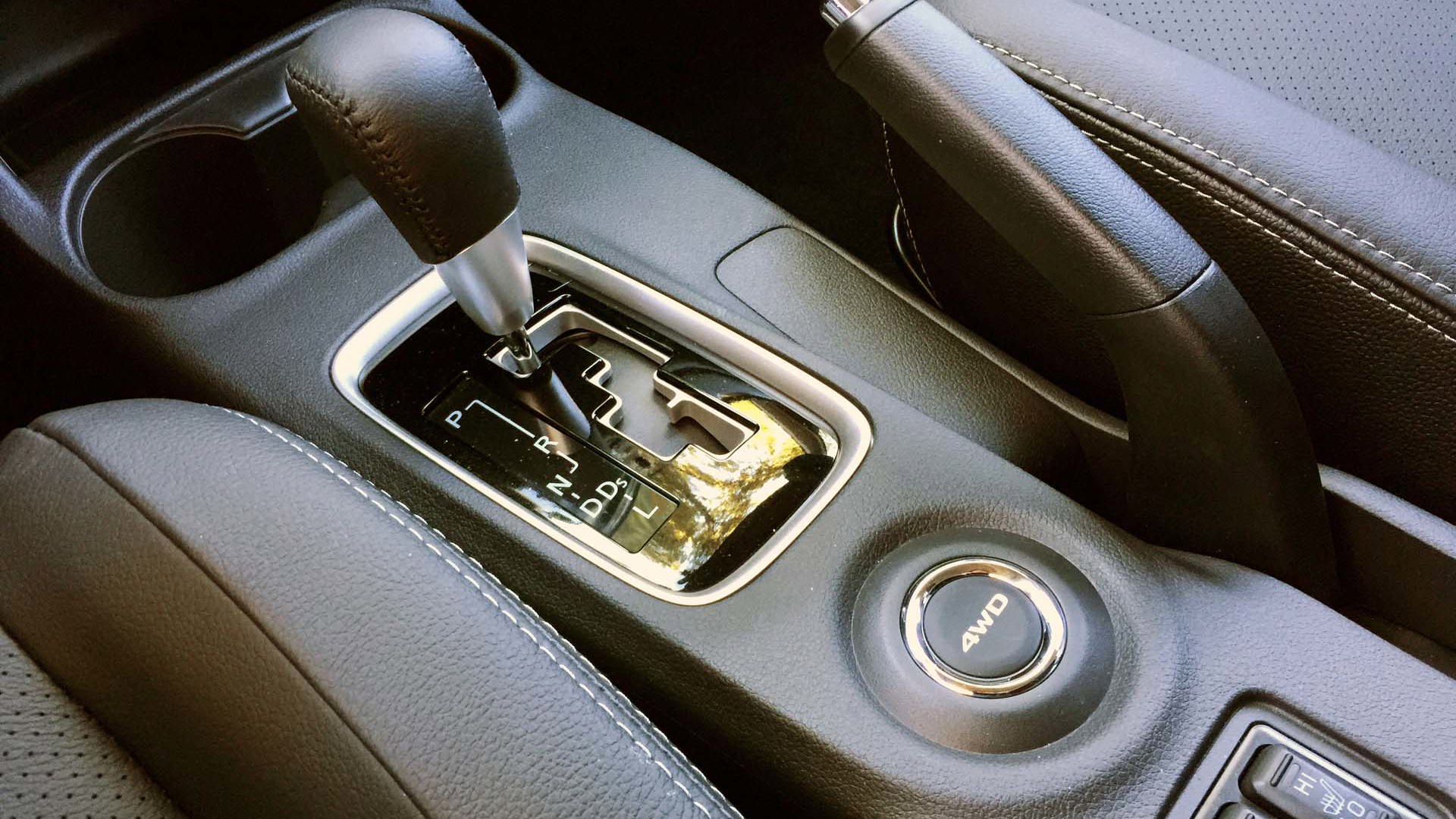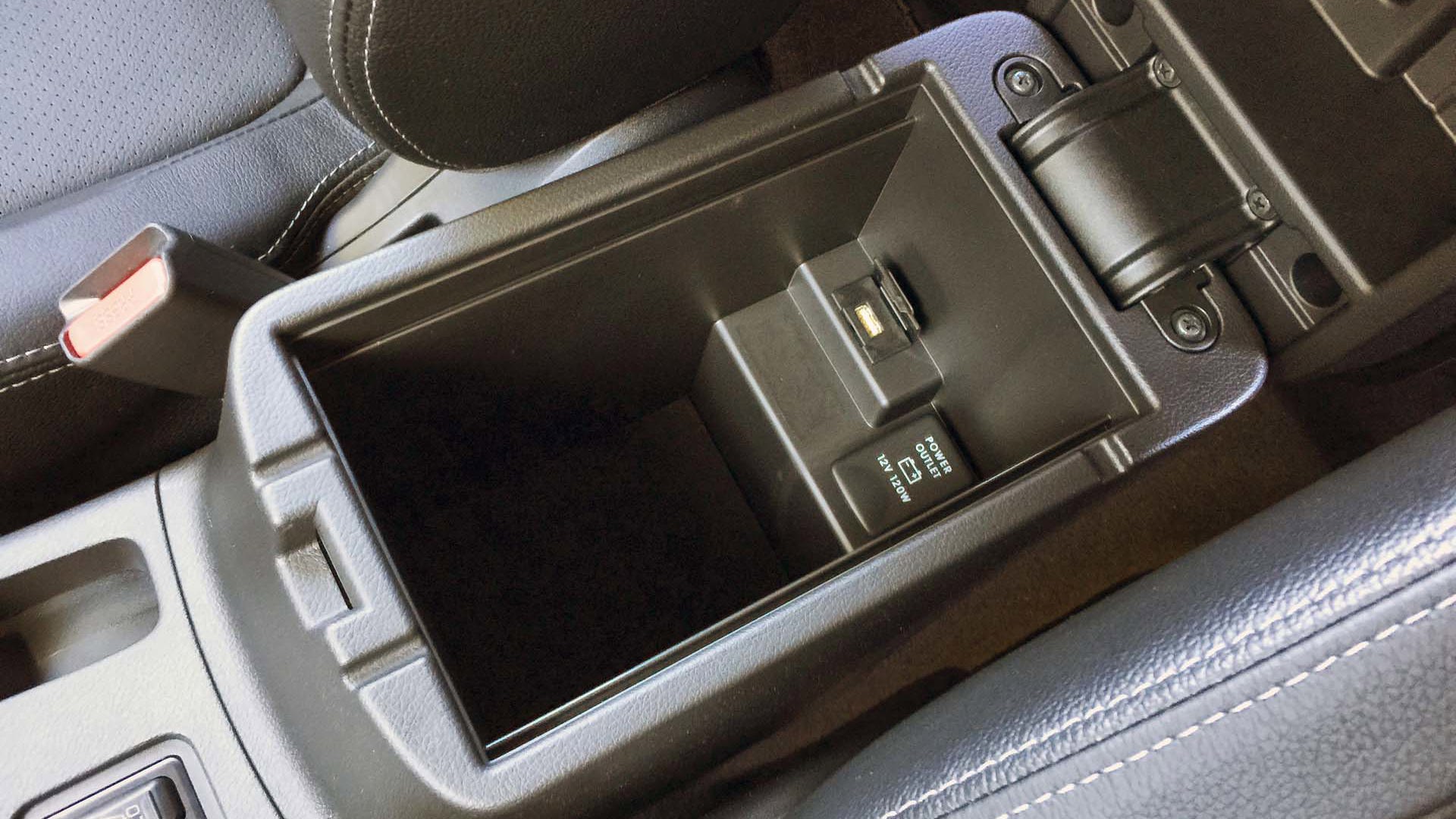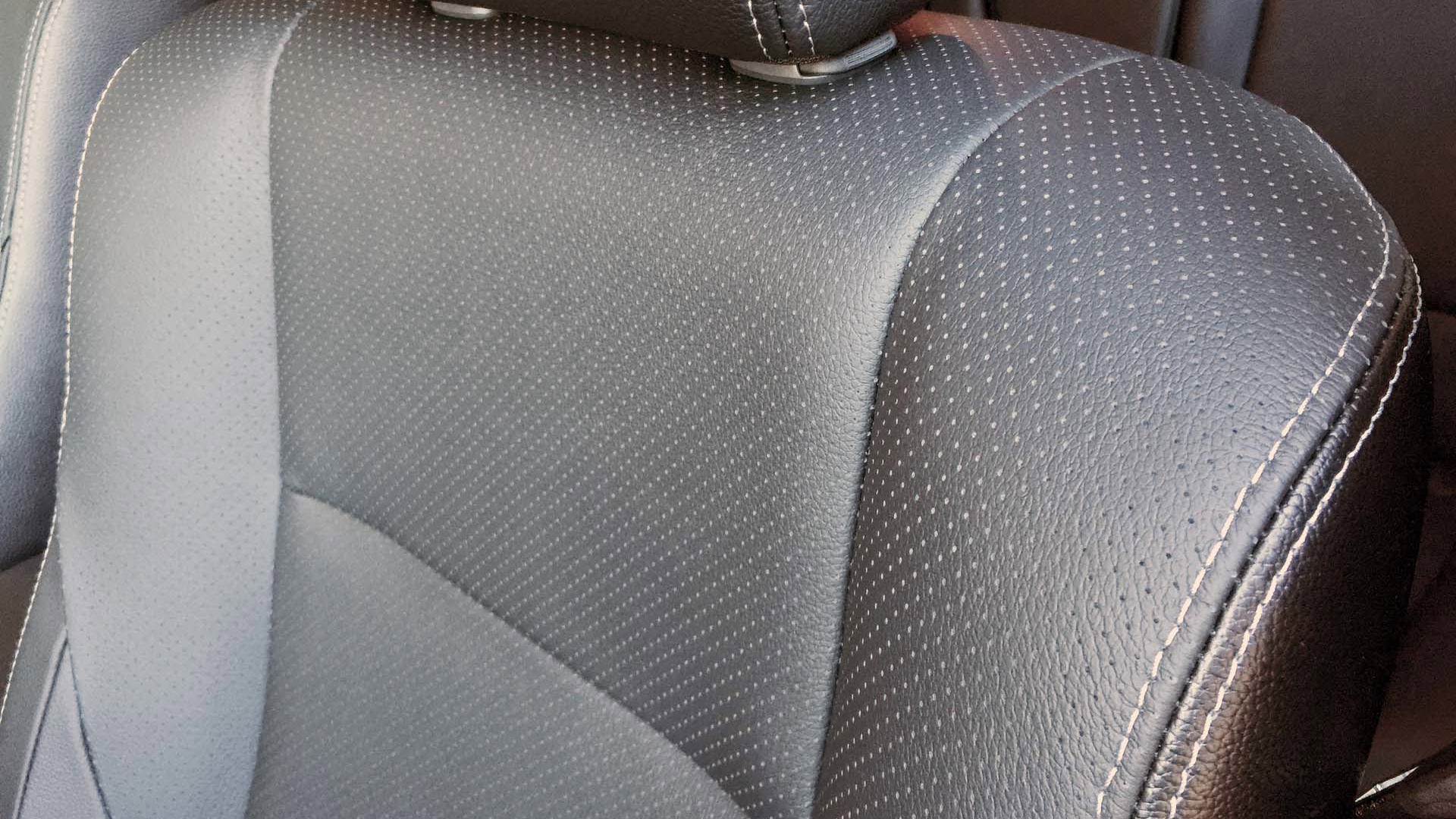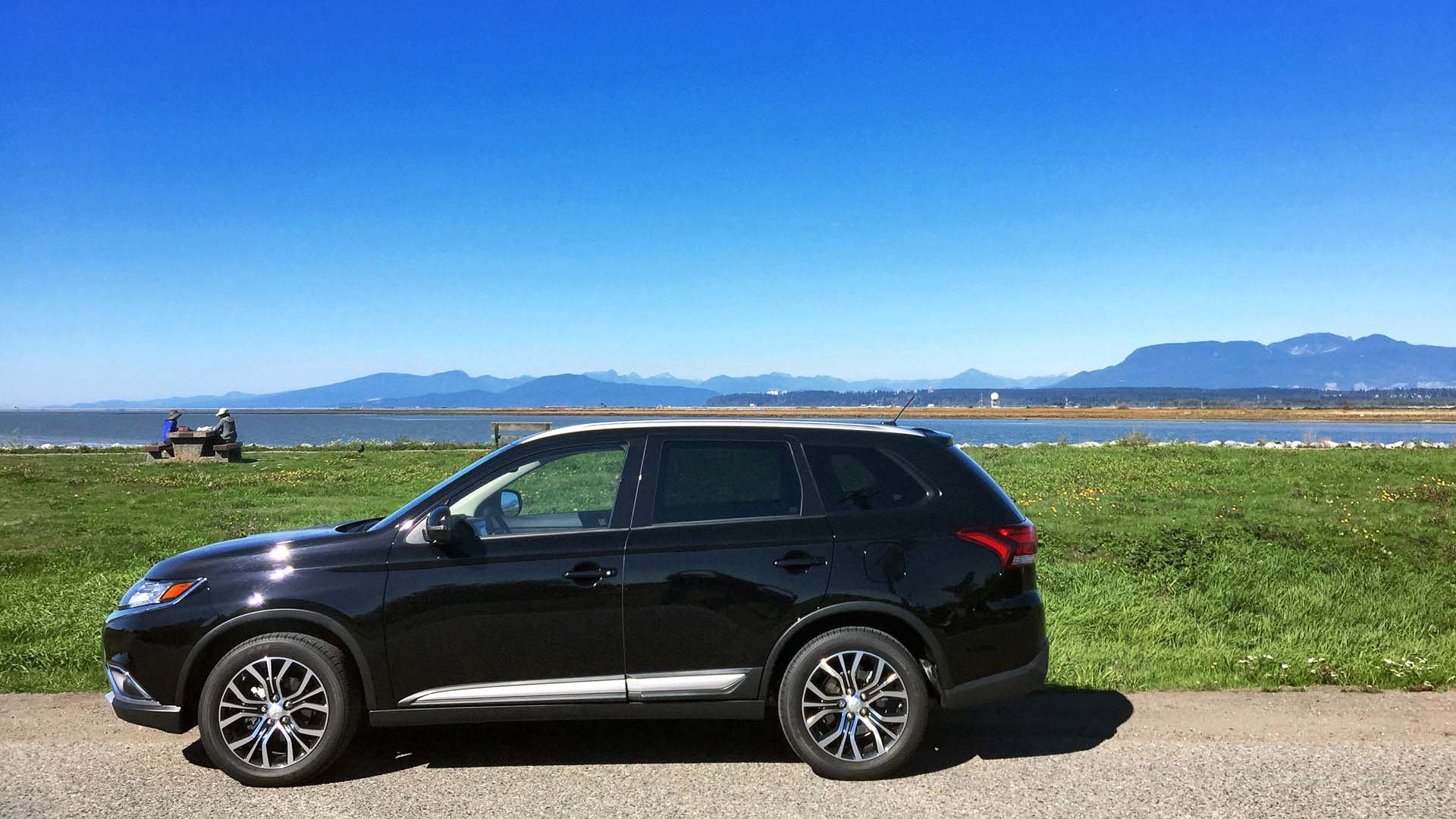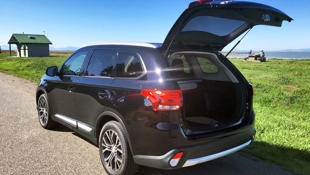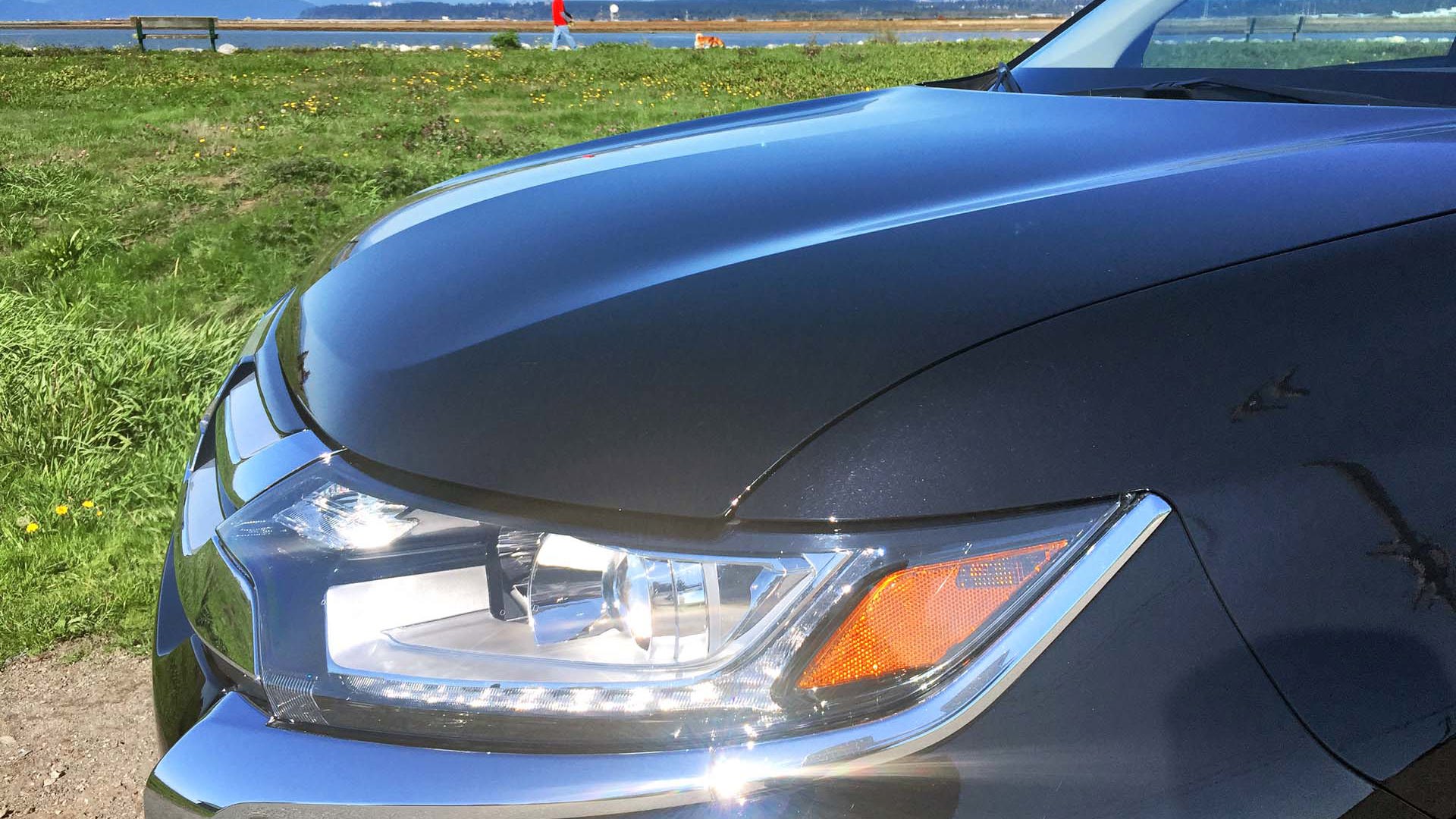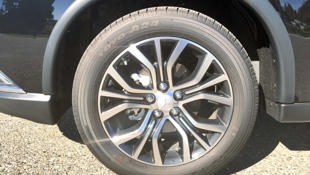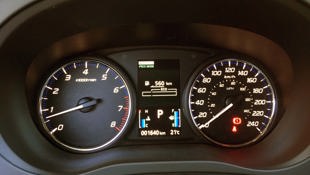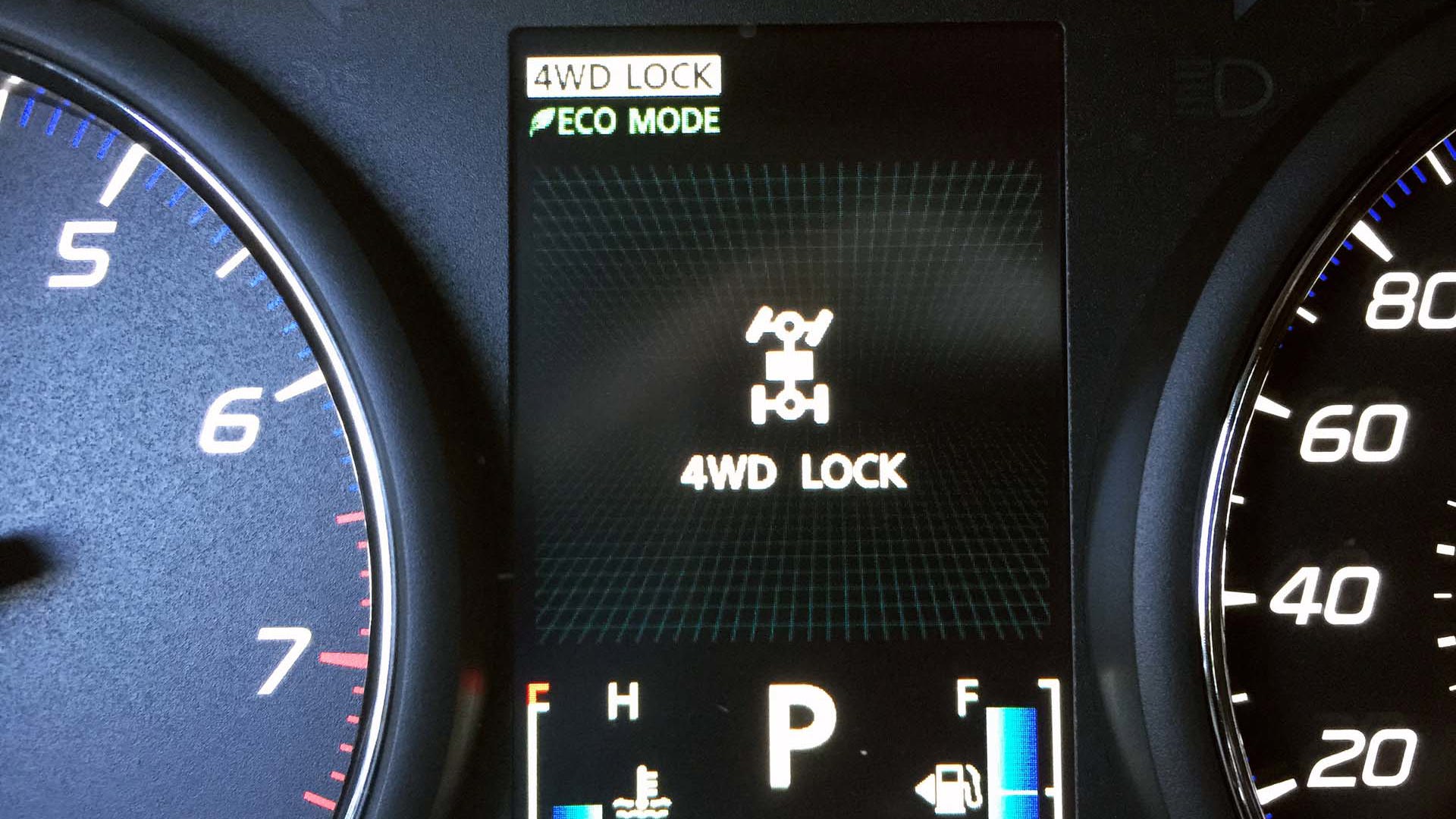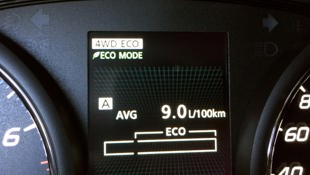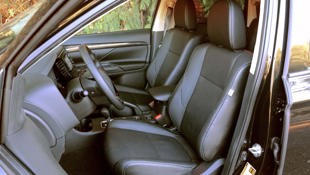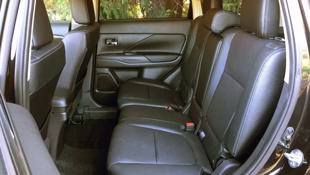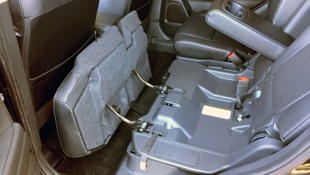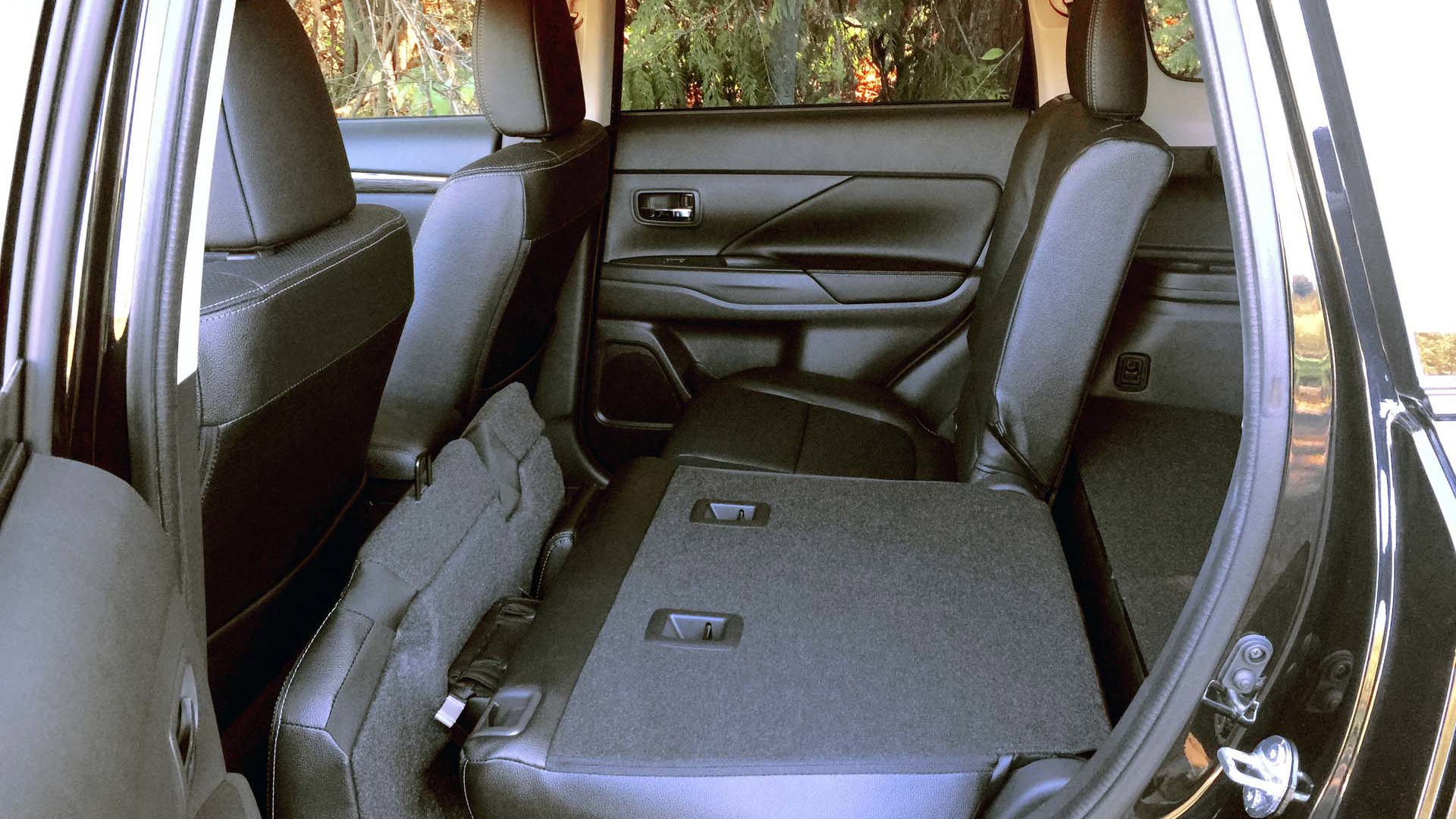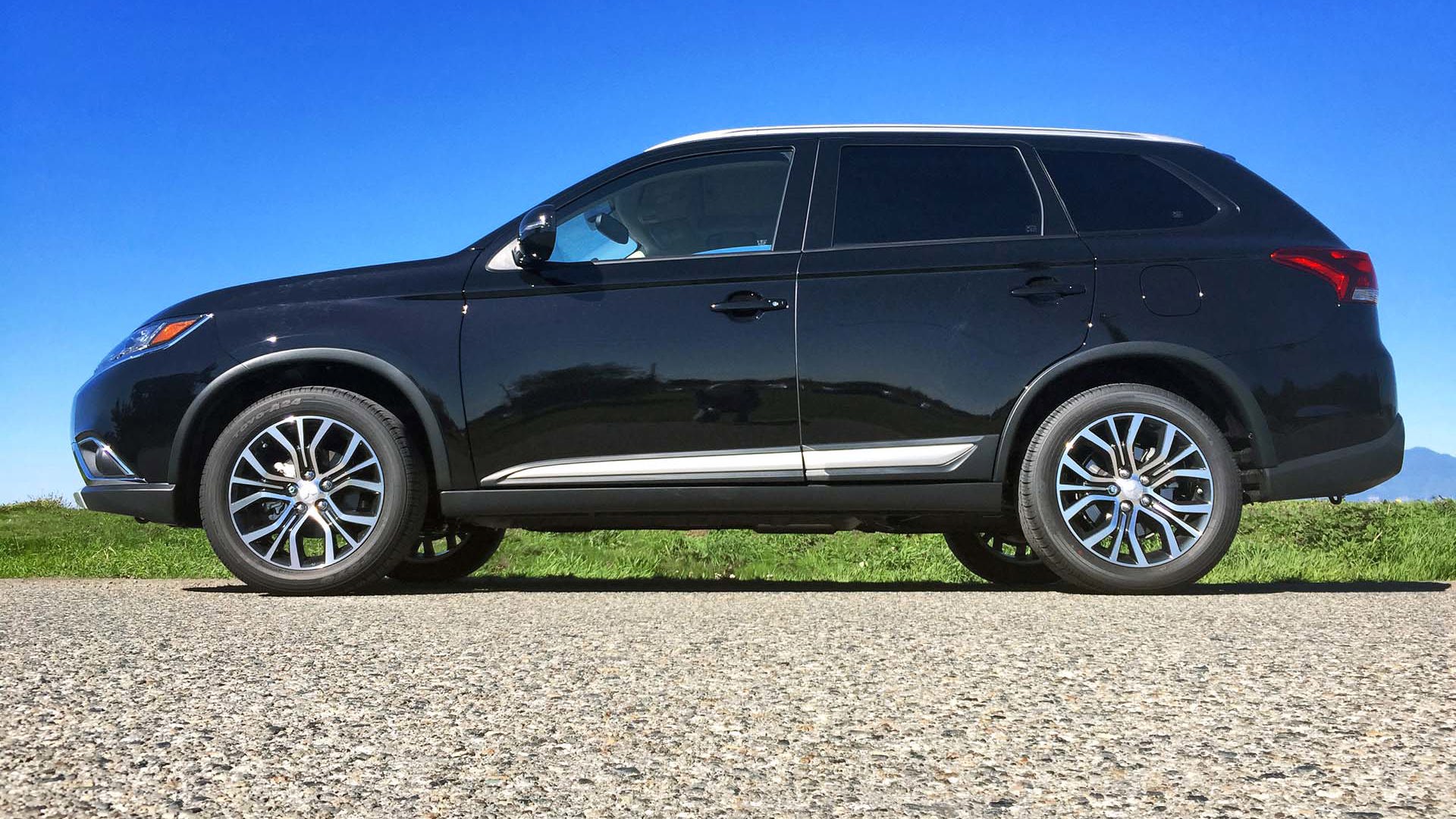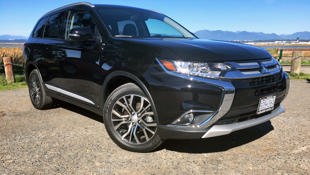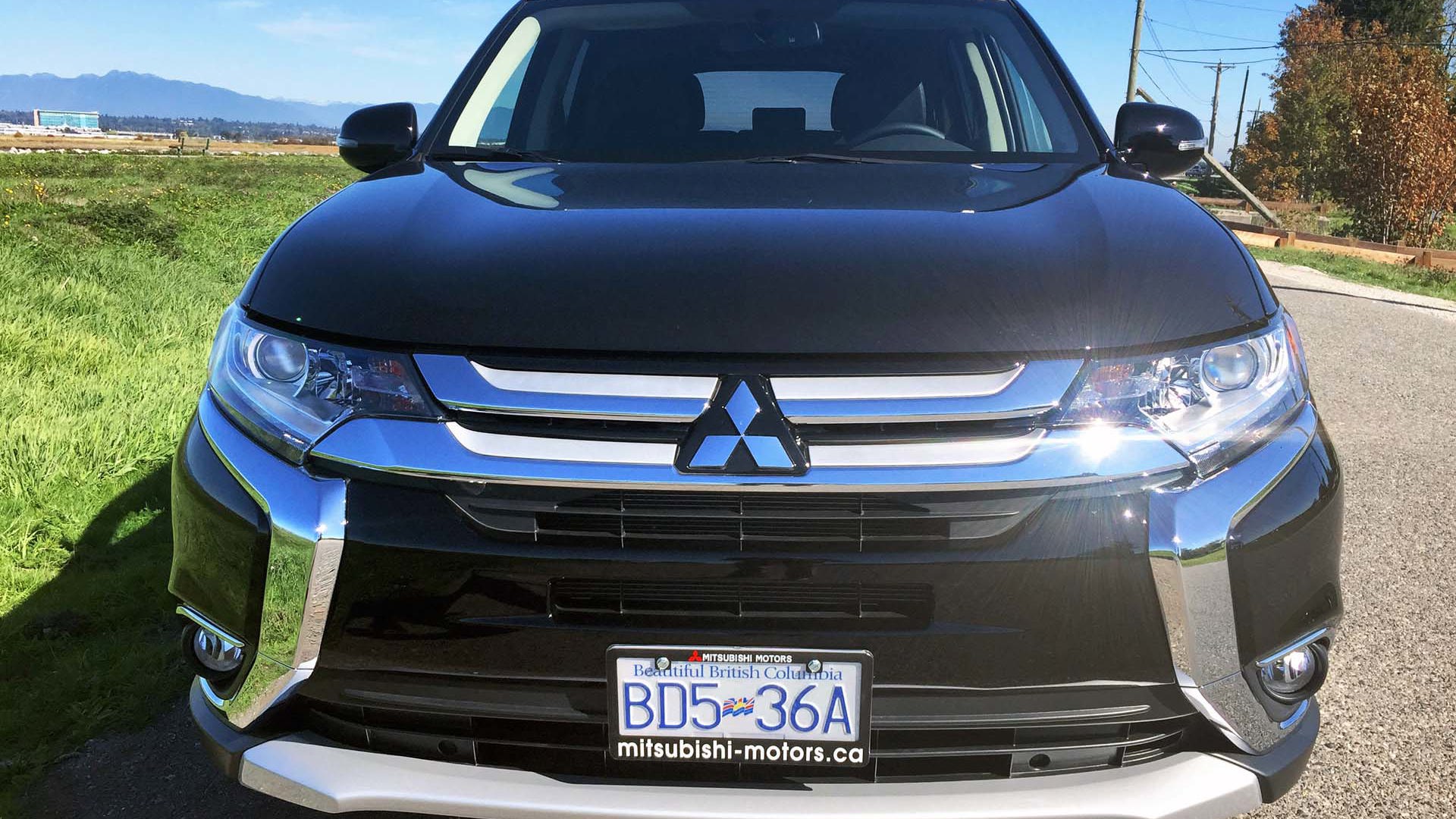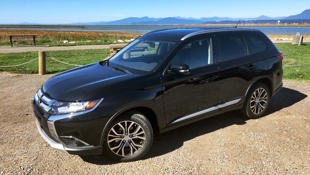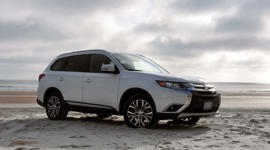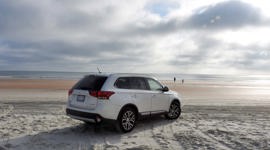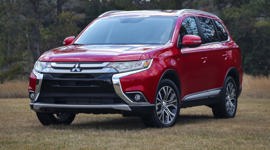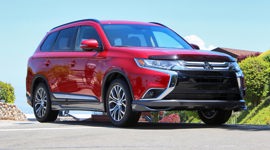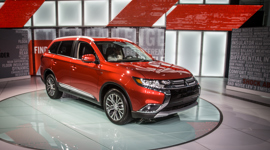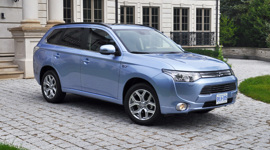Just two years after it was redesigned, the 2016 Mitsubishi Outlander receives freshened styling, an upgraded interior, increased sound insulation, structural improvements and more features. Now bolder and more imposing, the Outlander’s new face features a larger two-bar chrome grille and thick chrome strips on either side of the front of the bumper that wrap under the headlights, over the front fascia and down under the fog lights. The effect is to draw the eye forwards making the nose appear longer and pointier. I’m not totally convinced that this ribbon of chrome is a big improvement over last year’s model, but it’s certainly more distinctive.
The 2016 Outlander’s conservatively styled but user-friendly interior has gone pleasantly upscale.
At the rear, the new look is a little more successful: wider tail light lenses with LED lighting have extended into the liftgate area while reversing lamps have been integrated into the lower bumper.
The changes you can’t see are more significant: suspension revisions, increased body rigidity and adjustments to the electric power steering have helped improve the Outlander’s ride, drivability and steering feel, while extensive noise-reduction techniques such as better window insulation, added sound insulation in the engine compartment and increased use of acoustic foam in the body structure have significantly reduced interior noise, particularly in the four-cylinder model.
The 2016 Outlander’s conservatively styled but user-friendly interior has gone pleasantly upscale with a redesigned steering wheel with piano-black trim, higher quality seat materials, soft-touch dash surfaces, new trim for the dash and doors, enhanced dash display and navigation systems, and redesigned folding second-row seatbacks that are easier to operate.
As well, additional features are now available, such as LED daytime running lights, windshield wiper de-icer, and auto-dimming rearview mirror with Homelink garage door opener; availability may depend on the model and trim level.
Unlike most compact SUVs these days, the 2016 Mitsubishi Outlander is available with a choice of four or six-cylinder engines. Other automakers have dumped their V6 powerplants in favour of more fuel efficient turbocharged fours, but Mitsubishi kept their V6 - and they’re probably glad they did: the vast majority of Outlander’s sold in Canada have V6 engines. Having driven the redesigned Outlander V6 when it was introduced in 2014, I can understand why: Mitsubishi’s 3.0L V6 and six-speed automatic transmission is a smooth, quiet and powerful powertrain, and has a greater towing capacity than smaller four-cylinder engines. Here’s a full review of the V6-powered 2016 Outlander GT S-AWC.
Still, after having driven the refreshed 2016 Outlander ES AWC with the standard 2.4L four-cylinder engine and continuously variable automatic transmission for a week, I’d like to suggest that most people would be happier with the four. Not only is the four-cylinder engine more economical than the V6, but improvements to the 2016 Outlander have made it quieter with fewer vibrations felt in the cabin. And though the Outlander’s 166-hp 2.4L four is less powerful than the available 224-hp 3.0L V6, it offers sufficient power for all typical commuting needs - and it uses cheaper Regular gas rather than Premium grade.
Lastly, a nicely-equipped four-cylinder 2016 Outlander will cost you considerably less than a similarly-equipped six-cylinder Outlander.
See also: Comparison Test: Compact Crossover SUVs
The 2016 Outlander ES with front-wheel drive and standard four-cylinder engine starts at $25,998 while the all-wheel drive Outlander ES AWC four-cylinder has an MSRP of $27,998. Optional Touring Edition and Premium Packages can boost those MSRPs by $1,700 and $4,000 respectively.
V6 2016 Outlanders with all-wheel drive (AWC) start at $31,198 for the SE AWC, and $36,498 for the GT S-AWC. Optional navigation can boost this price to $38,498.
Other than its extra power, the V6 Outlander does have a couple of advantages: it has sliding rear seats and a fold-down third-row seat which increases seating capacity to seven people; however it’s a very small seat that’s suitable only for children. As well, the top-of-the-line Outlander GT S-AWC V6 model is available with advanced safety features that are not available in four-cylinder Outlanders such as a more advanced all-wheel drive system called Super All-Wheel Control and a suite of safety features Lane Departure Warning, Forward Collision Mitigation and Adaptive Cruise Control. If you want these features, you’ll have to buy the top-of-the-line V6 Outlander.
On paper, it appears that the Outlander is outmuscled by its four-cylinder competitors. To the Outlander’s 166 horsepower, the Honda CR-V offers 185, Toyota RAV4 176, Ford Escape (1.6T) 173, Nissan Rogue 170, and Hyundai Tucson 175. The Outlander’s engine is also not as torquey, particularly when compared to the Tucson and Escape’s turbocharged engines. The Outlander’s maximum torque of 162 lb-ft compares to the the CR-V with 181, RAV4 172, Escape 184, Rogue 175, and Tucson with 195.
Published estimates of the 2016 Outlander’s acceleration times (I4, AWD) show an estimated 0 to 100 km/h time of 11.1 seconds . That’s slower than its primary competitors as well as the previous generation Outlander which had a 0 to 100 km/h time of 10.9 seconds.
However, after driving my 2016 Outlander for a few days, I became suspicious of these published acceleration times: my 2016 Outlander seemed quicker. So I decided to do my own acceleration tests with a hand-held stopwatch. To maximize CVT gearing, I tapped the shift lever from ‘D’ over to the right into ’D Sport’ mode. Then, using a freeway on-ramp (to avoid undue attention from cell-phone toting bystanders), I accelerated from a standing start to 100 km/h. My time was just under 10 seconds. That’s better than the Nissan Rogue (10.7 sec), about the same as the Toyota RAV4 (9.9 sec) and Ford Escape 1.6T (9.9 sec), and not far behind the Honda CR-V (9.4 sec). The Hyundai Tucson 1.6T (8.8 sec) is quicker.
The Outlander’s better-than-expected acceleration may be due in part to the Outlander’s relatively light curb weight of 1,535 kg – that’s over 100 kg lighter than a Ford Escape 1.6T and 65 kg lighter than a Toyota RAV4.
During my week driving the Outlander in both hilly and flat territory around Vancouver, I never felt that it was underpowered for typical city and freeway driving needs, and if better acceleration was required, I’d just slap the shift lever into Sport mode to raise the engine revs.
However, like most four-cylinder compact SUVs with limited torque, a full load of passengers and cargo will tax its performance. As well, its towing capacity of 1,500 lb compares to the Outlander V6 with 3,500 lb.
Fuel economy is good: its NRCan official city/hwy/combined rating is 9.7/8.1/9.0. That’s better than the Toyota RAV4 2.5 (10.5/8.2/9.5), Ford Escape 1.6T (10.6/8.0/9.4), and the Hyundai Tucson 1.6T (9.8/8.4/9.0) but not quite as good as the Honda CR-V 2.4 (9.1/7.2/8.3) and Nissan Rogue 2.5 (9.2/7.2/8.3). In mixed city/highway driving, my Outlander was averaging about 9.1 L/100 km, increasing to over 11 in stop-and-go city traffic.
That’s way better than the Outlander V6 which rates 11.9 city/8.5 hwy/10.4 combined, and in which our reviewer averaged 13.0 L/100 km in his week of driving.
While the Outlander V6 has a six-speed automatic transmission, the Outlander’s four comes with a continuously variable transmission (with Sport mode). The primary difference between the two transmissions is that the CVT has no distinct gear changes and sustains engine revs at a high level while accelerating. That said, the Outlander’s engine/CVT combination is relatively quiet and vibration-free especially at low speeds and when cruising on the freeway. At 100 km/h, the engine revs at just 1,800 rpm.
Outlanders equipped with all-wheel drive (which Mitsubishi calls all-wheel control or AWC) vary torque from front to back depending on conditions. In addition, to save a little gas, the AWC system includes a driver-selectable 4WD Eco mode (using a 4WD button on the console) which alters throttle responsiveness and CVT performance to reduce consumption. Frankly, I didn’t find a huge difference in performance between 4WD Eco and 4WD Auto (default) modes. Acceleration is slower in 4WD Eco mode, but if you need to accelerate quickly, a harder push on the accelerator will produce adequate power.
Unlike many of its AWD competitors, the Outlander has a 4WD Lock mode which locks up front:rear torque distribution in a 50/50 split at slower speeds. This can be very handy if you run into unexpectedly deep snow, gravel, ice, mud or other loose traction surfaces. The Outlander also has a decent ground clearance of 215 mm (8.5 in) and a reasonably tight turning circle of 10.6 m (34.8 ft) Our test vehicle came with 225/55R18-inch Toyo all-season tires which are part of the optional Premium Package (16-inch tires are standard).
Pressing the big green ‘Eco’ button on the dash turns 4WD Auto and 4WD Lock modes into Eco mode. I found this rather confusing since there is already a 4WD Eco mode available simply by pressing the 4WD button on the centre console. And I wonder why anyone want to reduce power in 4WD Lock mode if they’re trying to extricate the vehicle from a snowbank? The Eco button seems quite unnecessary.
In addition to the safety benefits of AWC, the Outlander ES AWC has all the usual safety features: ABS, traction control, stability control, electronic brake force distribution, brake assist and Hill Start Assist, the latter to stop it rolling back when starting on a hill. Mitsubishi’s Super All-Wheel Control, which adds side-to-side torque vectoring capabilities to the front wheels, is available only in the top GT S-AWC model, not in four-cylinder models.
Around town, the Outlander is easy to drive and soaks up road patches, pavement cracks and potholes without any clunking or rattling. The body structure feels very solid. The ride is firm but pleasant and the handling is very stable, limited only by the Outlander’s tall height and ground clearance. The Outlander doesn’t feel tipsy, but neither does it have the nimble handling of a CR-V or CX-5 or the planted feel of a 2016 Hyundai Tucson.
In crash tests by the IIHS, the 2015 Outlander received the Top Safety Pick+, the highest rating available.
Our tester had the optional Premium Package ($4,000) which includes keyless door locking/unlocking by pushing a black button on either front door. It also includes pushbutton ignition which means that you never have to take the vehicle key out of your pocket. Once you’ve tried this system, you won’t want to go back.
Four big doors offer easy access to the front and rear passenger compartments although there is a small ledge to step over. In the driver’s seat, visibility is very good thanks to a tall cabin and big windows. The electric-assist steering seems well-weighted and the Outlander is generally easy to drive and easy to park. A rearview camera comes with the Premium Package but not rear parking sensors. The only thing I missed in the ES AWC was automatic headlights.
The cabin is roomy with generous rear legroom and adequate rear headroom; the optional sunroof seems to take up some of the available headroom. The reclining rear seats are quite firm but a rear passenger of mine said they felt just fine.
The optional black leather interior of our ES AWC tester had a classy appearance: niceties include soft-touch dash materials, perforated seats, leather wrapped steering wheel and shift knob with piano black trim on the steering wheel and around the centre screen and audio system, thin aluminum trim around the centre stack and the dark grain trim on the dash and doors.
With the Premium Package, the driver’s seat includes power height, fore-aft and recline, but no power lumbar. The front passenger seat, however, has no power functions. Even without adjustable lumbar support in the driver’s seat, I felt comfortable after a week of driving. Both front seats have seat heaters.
Behind the steering wheel, the instruments are bright and easy to read as is the trip computer display between the gauges. Using a menu button on the dash near the door, the driver can scroll between information such as average fuel economy, average speed, distance to empty, odometer and other trip values.
Included with the Premium Package is a 6.1-inch centre touchscreen with bright graphics and large on-screen buttons. It’s complemented by hard buttons some of which duplicate the on-screen buttons. As the centre dash protrudes towards the driver, the controls are easy to reach but I found the dual-zone climate control buttons difficult to see while wearing sunglasses.
At the bottom of the centre stack is an open bin and 12-volt power outlet where you can store a phone or camera. There’s also a deep storage bin with a USB port and another 12-volt power outlet under the centre armrest. This bin also has a coin tray, tissue holder, and pen holder.
At the rear, the split seatbacks fold down in a three-step process: first pull up on the lever on top of the seatback and flip down the rear head restraint, then flip up the seat cushion against the front seatback, and then fold down the seatback. This provides a completely flat loading surface but it’s a bit of a chore and must be done for both sides. If you don’t want to go to all that trouble, just fold down the seatbacks onto the seat cushions - but it won’t be completely flat.
The cargo area is spacious with 968 litres behind the rear seats and 1,792 L with the rear seats folded down. Still, it lags behind some of its competitors such as the Toyota RAV4 (1,090/2,080L), Ford Escape (971/1,920L) and Nissan Rogue (1,112/1,982L). The cargo area includes a lined floor, plastic side walls, and two large open bins behind the rear wheelwells. A bonus is two very large storage bins underneath the floor that extend the width of the trunk - very handy for storing snow brushes, jumper cables, chains and other stuff you don’t use every day. A sliding privacy cover hides the contents of the cargo area from curious eyes and is removable when transporting bulkier items.
Like all Mitsubishis in Canada, the Outlander comes with an excellent warranty: 5 years or 100,000 km complete and 10 years or 160,000 km powertrain warranty - as well as a 5 years unlimited mileage roadside assistance coverage.
Though not as well-known as other SUVs, the Mitsubishi Outlander competes on just about every level with better-known models, and the changes made for 2016 have improved it.
The 2016 Mitsubishi Outlander is built in Mizushima, Japan.
| Warranty: 5 years/100,000 km; 10 years/160,000 km powertrain; 5 years/unlimited distance corrosion perforation; 5 years/unlimited distance roadside assistance Competitors: |
| Model Tested | 2016 Mitsubishi Outlander ES AWC |
|---|---|
| Base Price | $27,998 |
| A/C Tax | $100 |
| Destination Fee | $1,700 |
| Price as Tested | $34,187.65 |
|
Optional Equipment
$4,389.65 (Premium Package $4,000: 18-inch all-season tires and alloy wheels, front fog lights, leather upholstery, power driver’s seat, dual-zone automatic climate control, touch-screen with 140-watt AM/FM/CD/MP3 audio with six speakers, SiriusXM satellite radio, w/3 months subscription, rearview camera, high-contrast tachometer and speedometer, keyless entry and ignition, auto-dimming rearview mirror, Homelink garage opener, silver roof rails, power moonroof with sunshade; Labrador Black Pearl paint $160.00; rear sliding tonneau cover $229.65)
|
|
